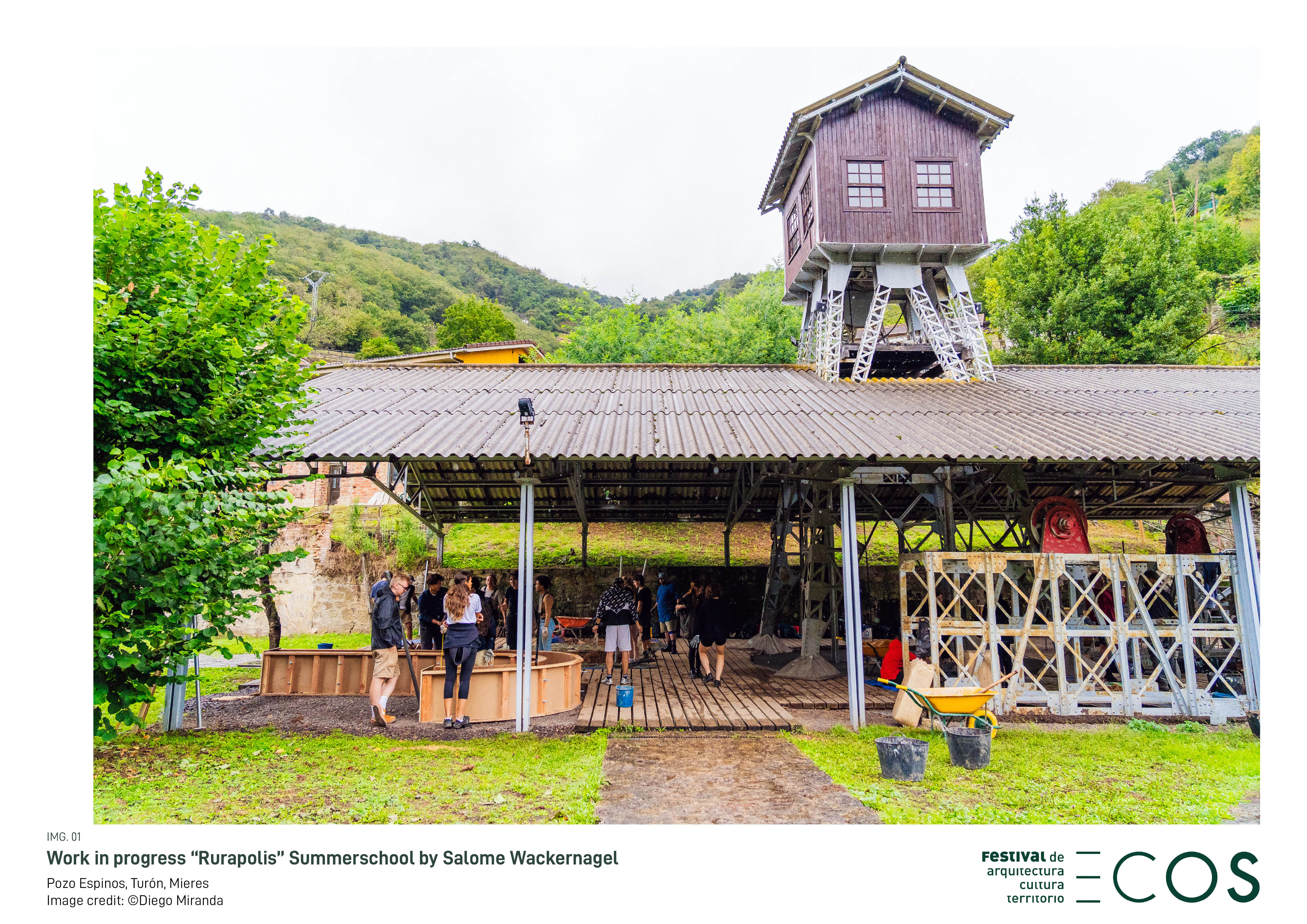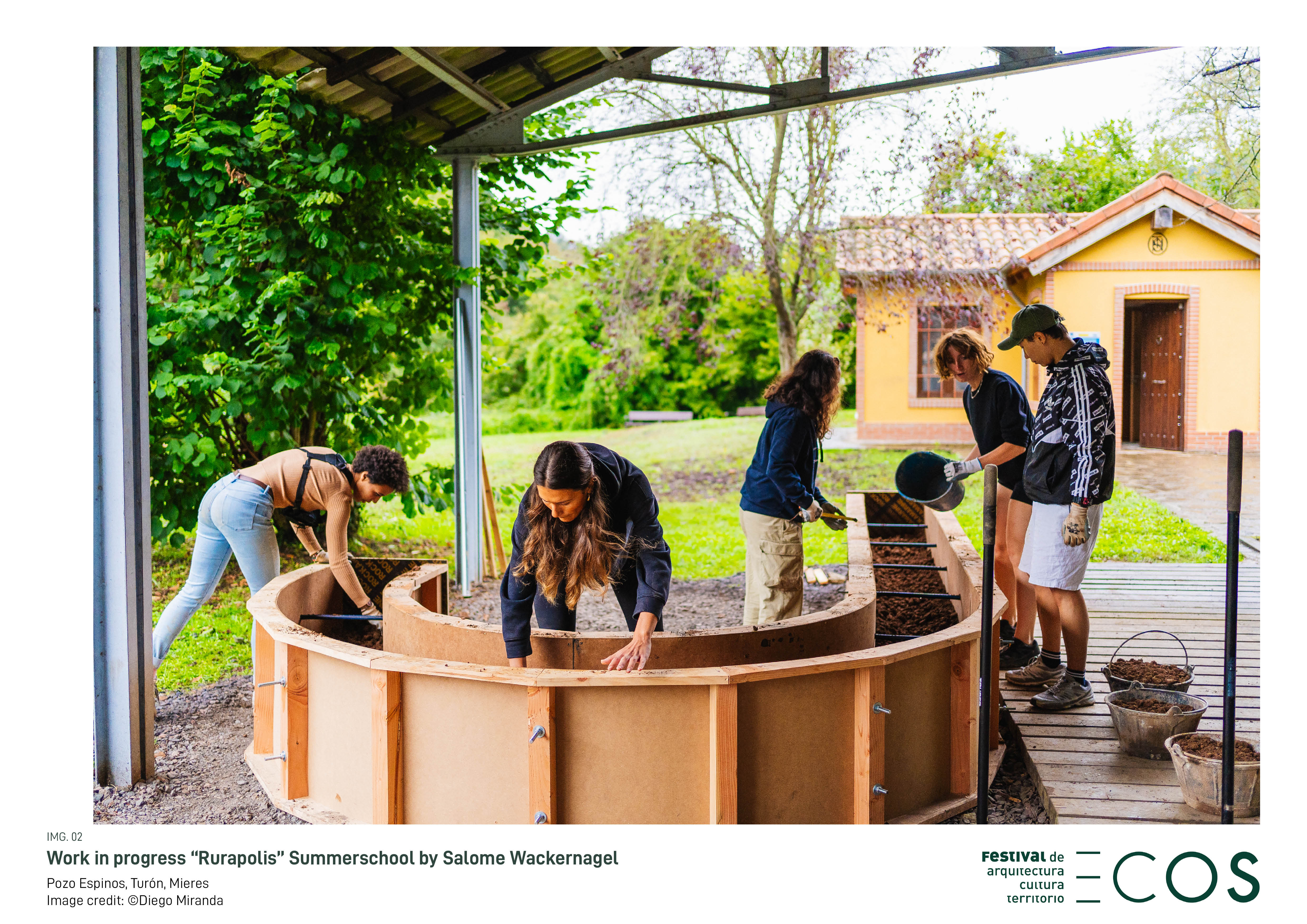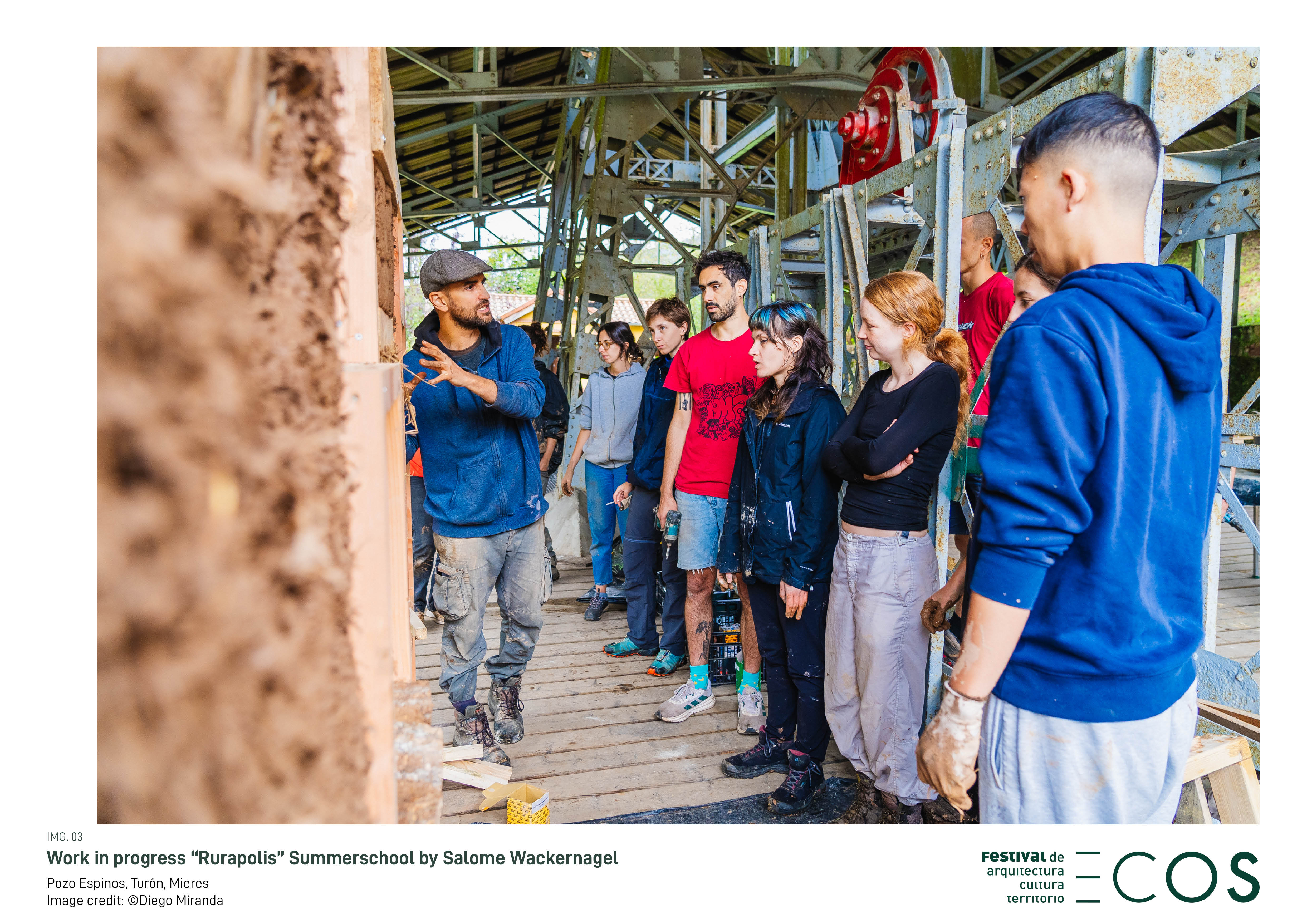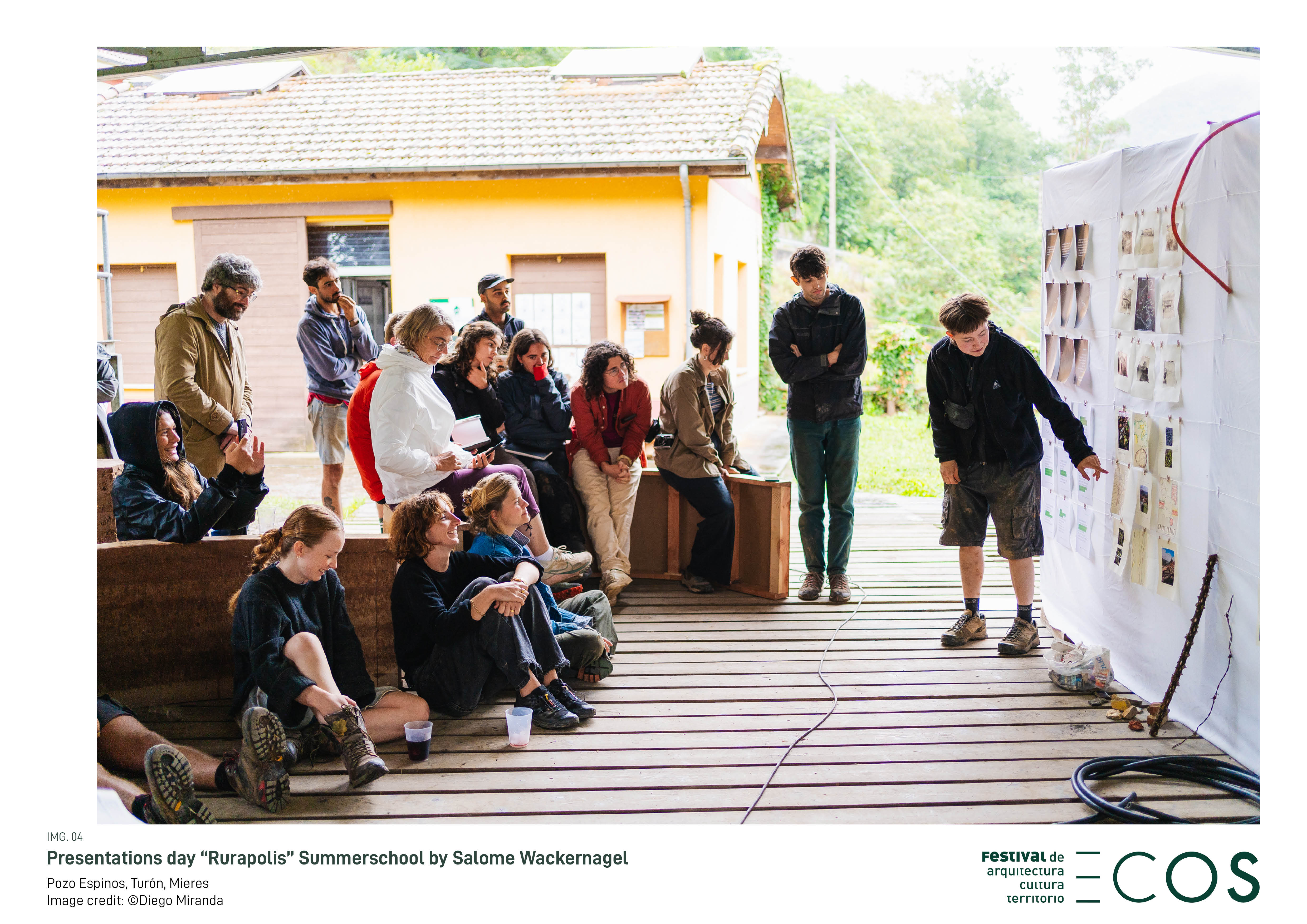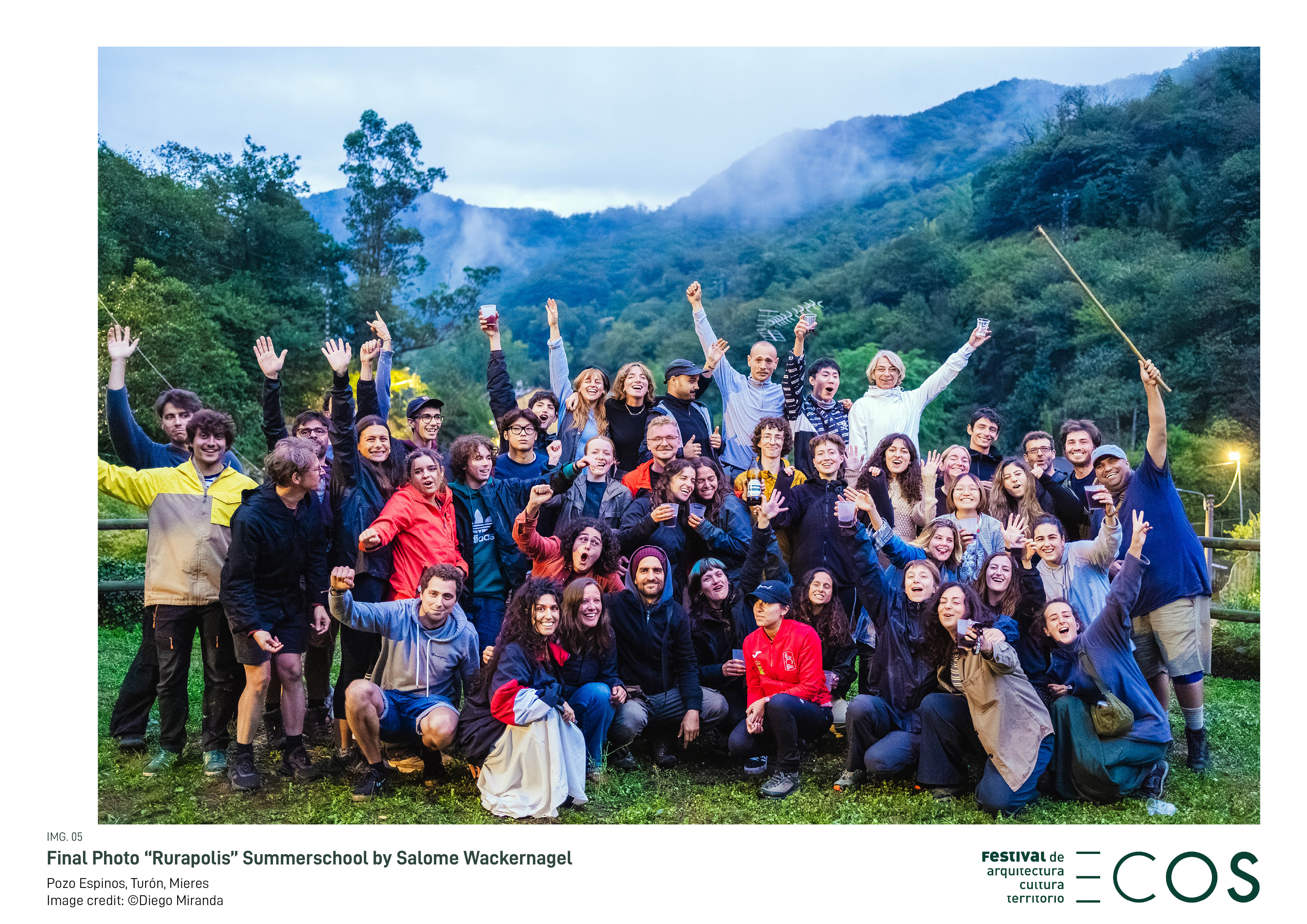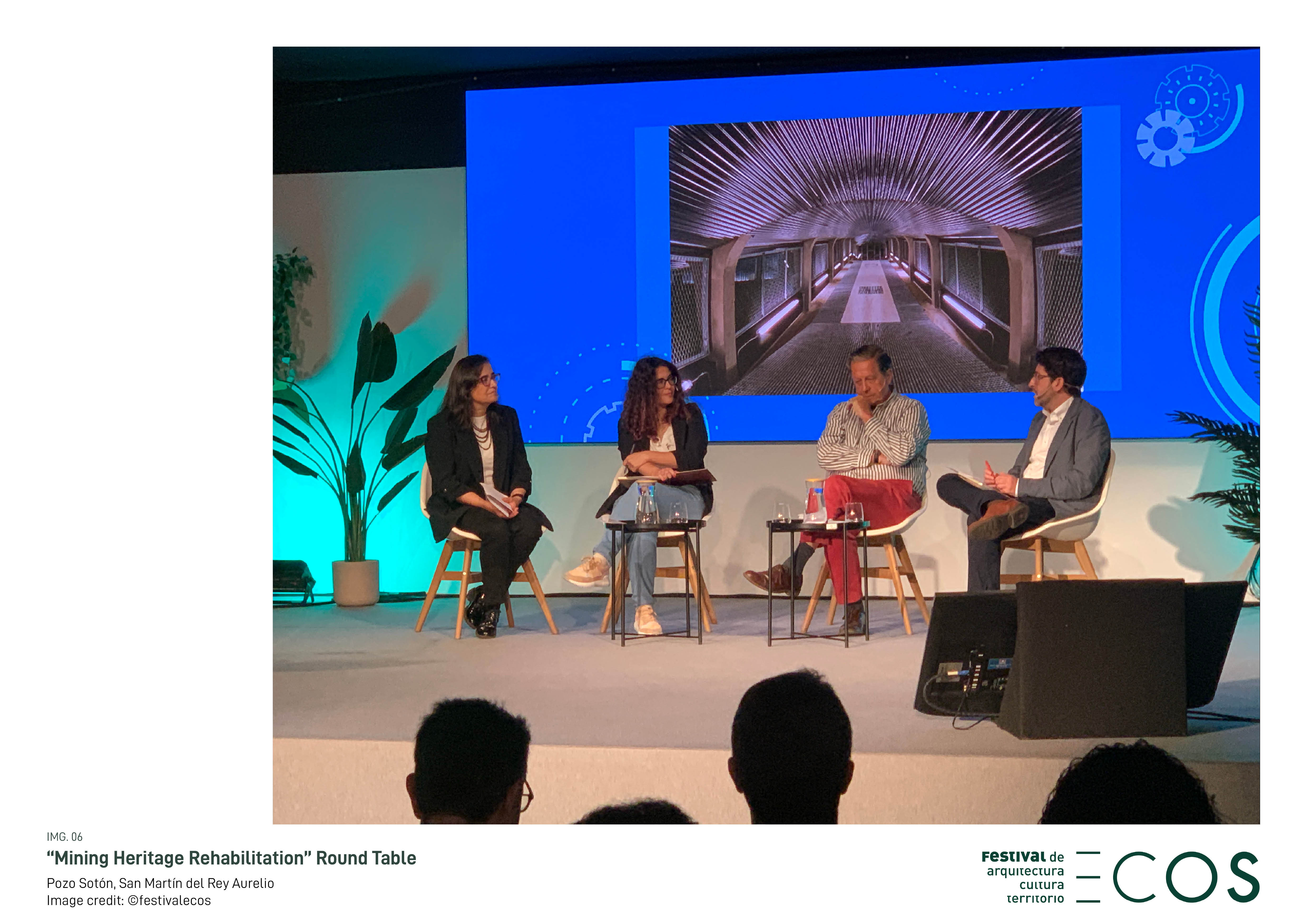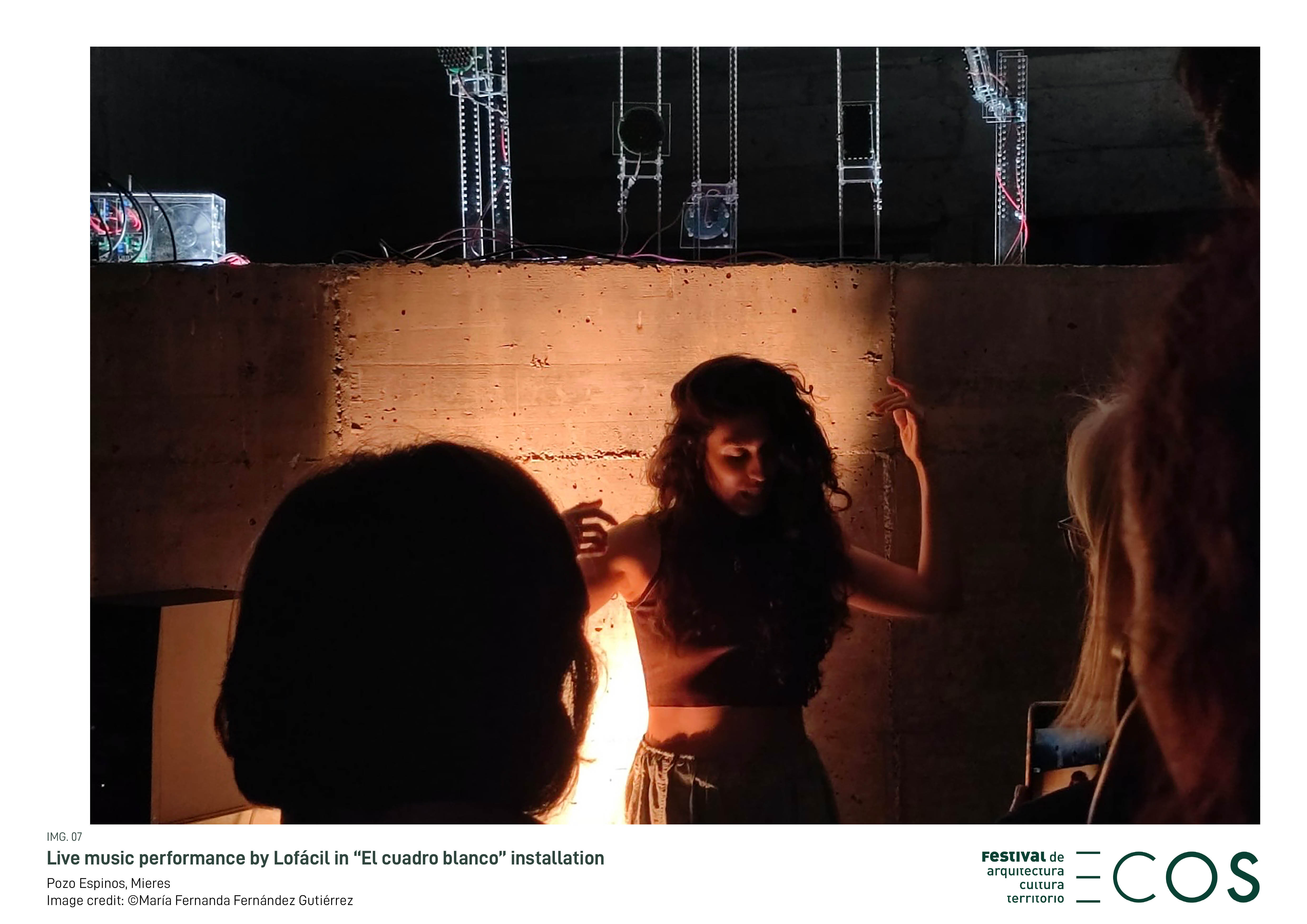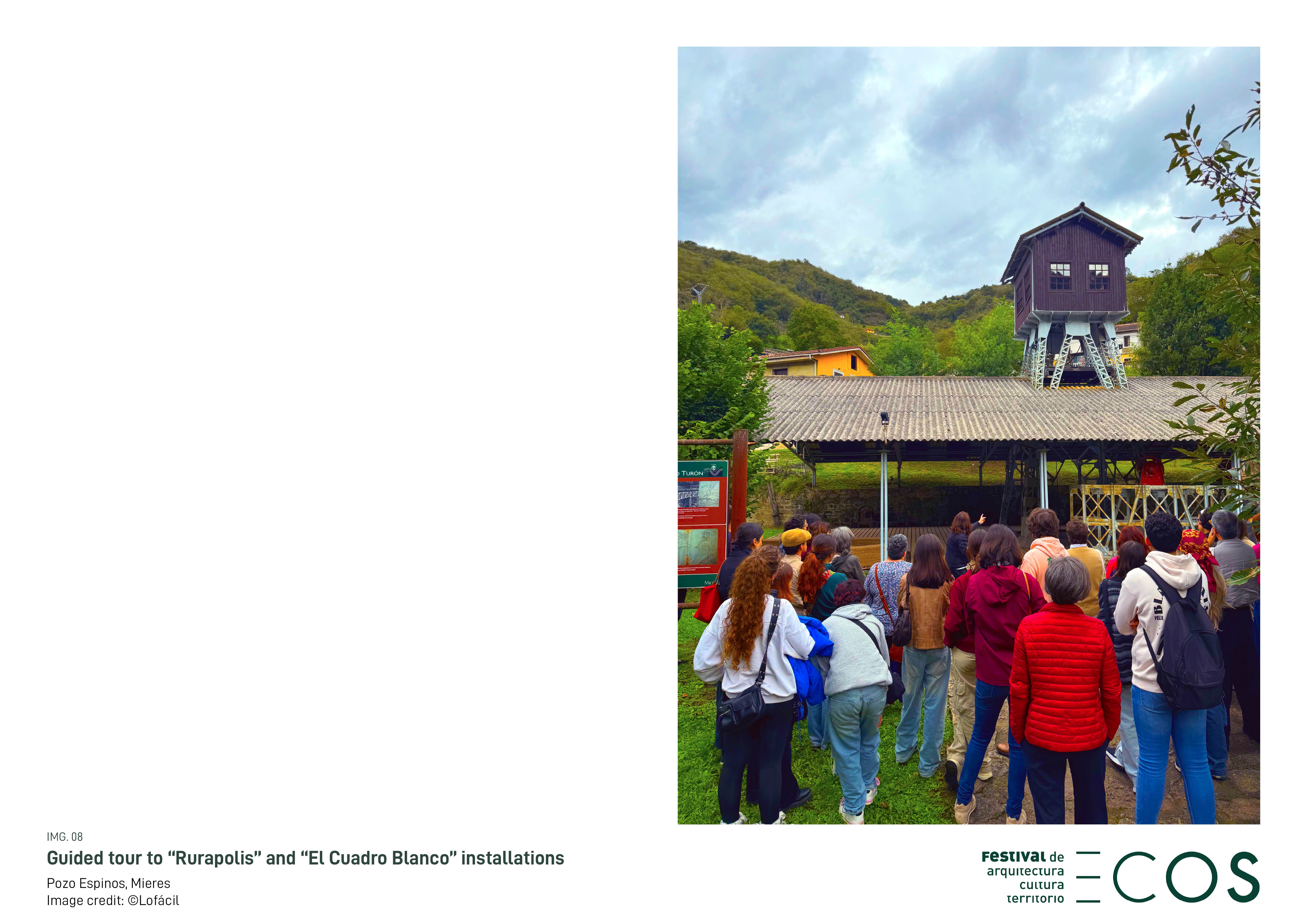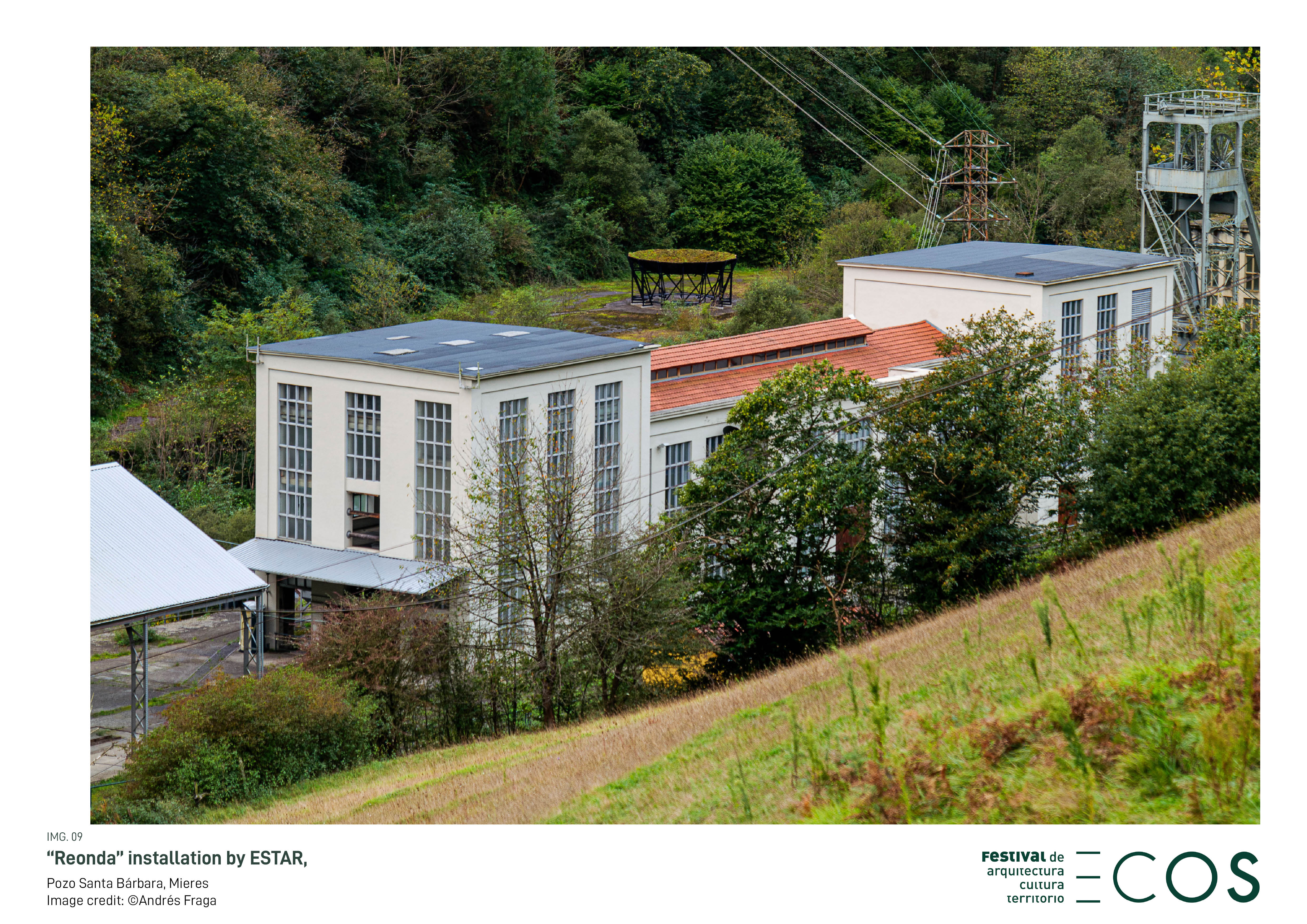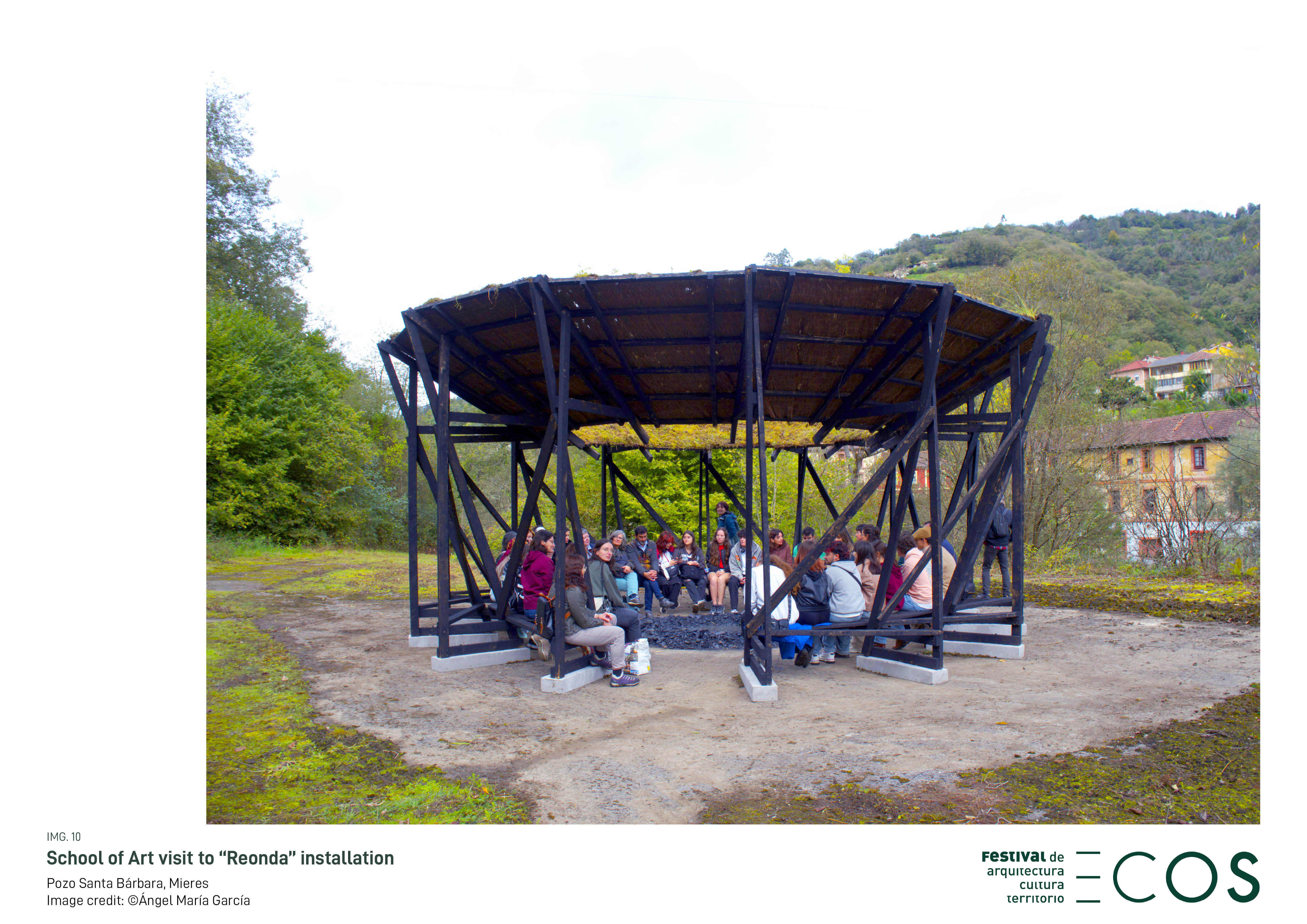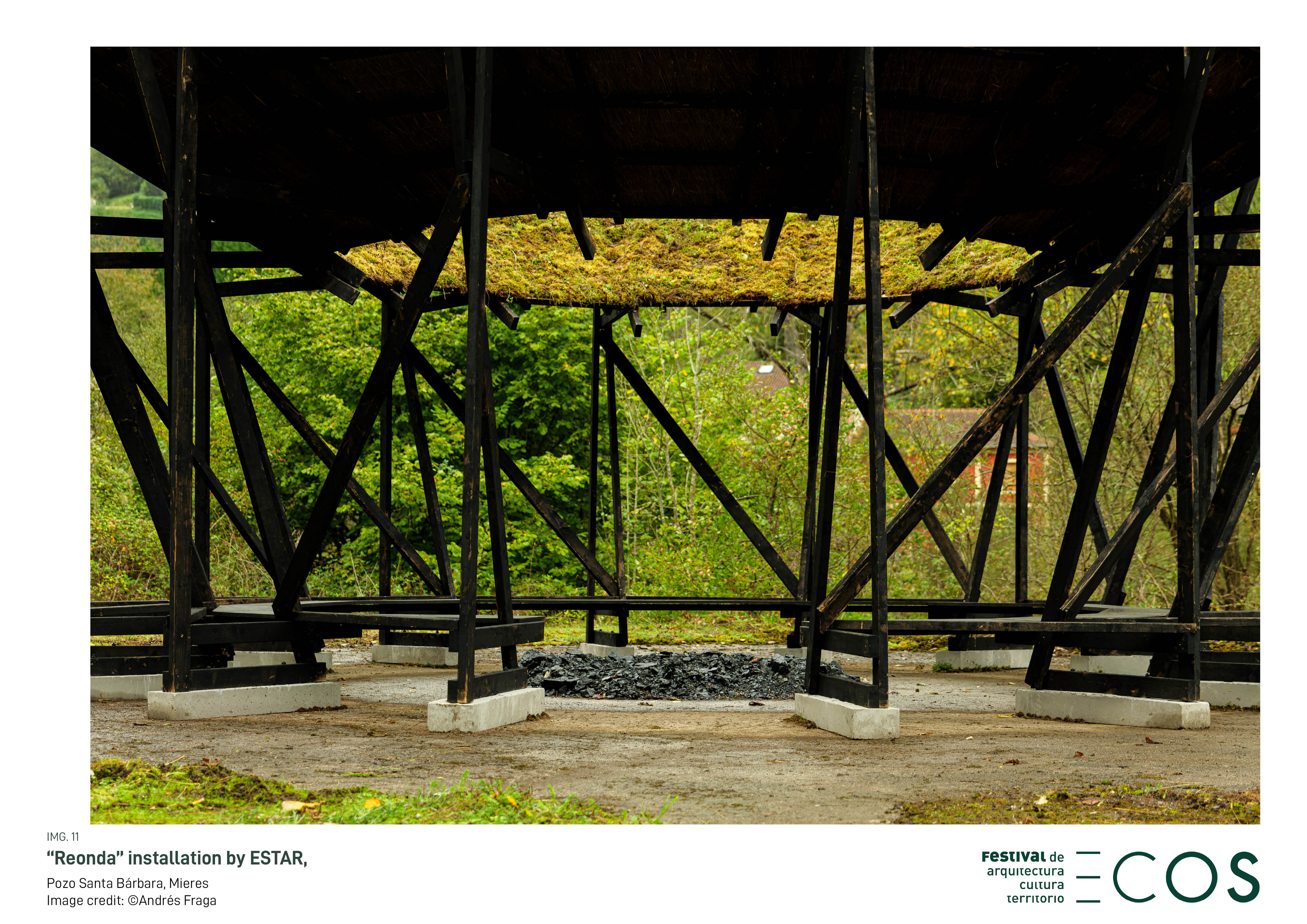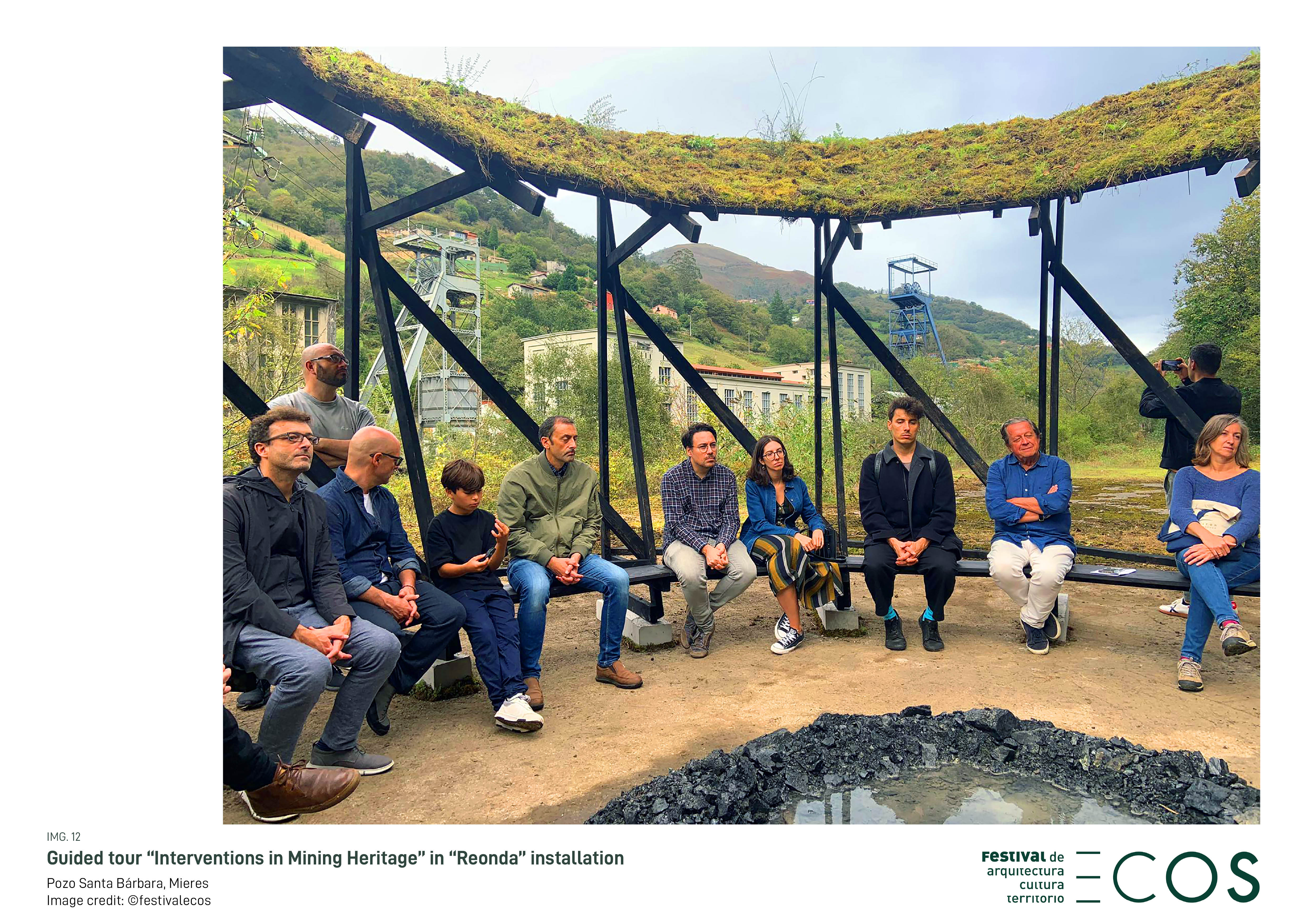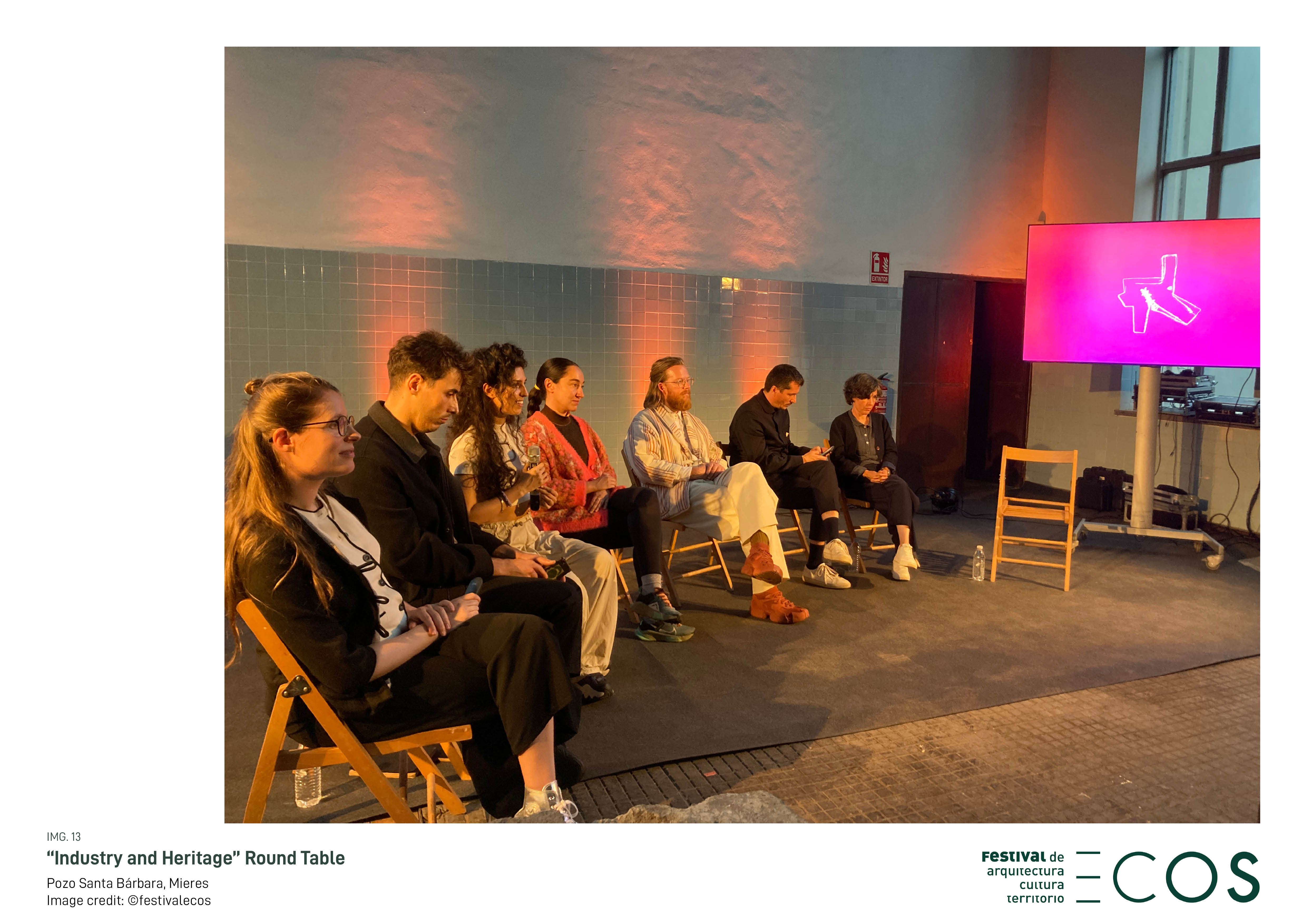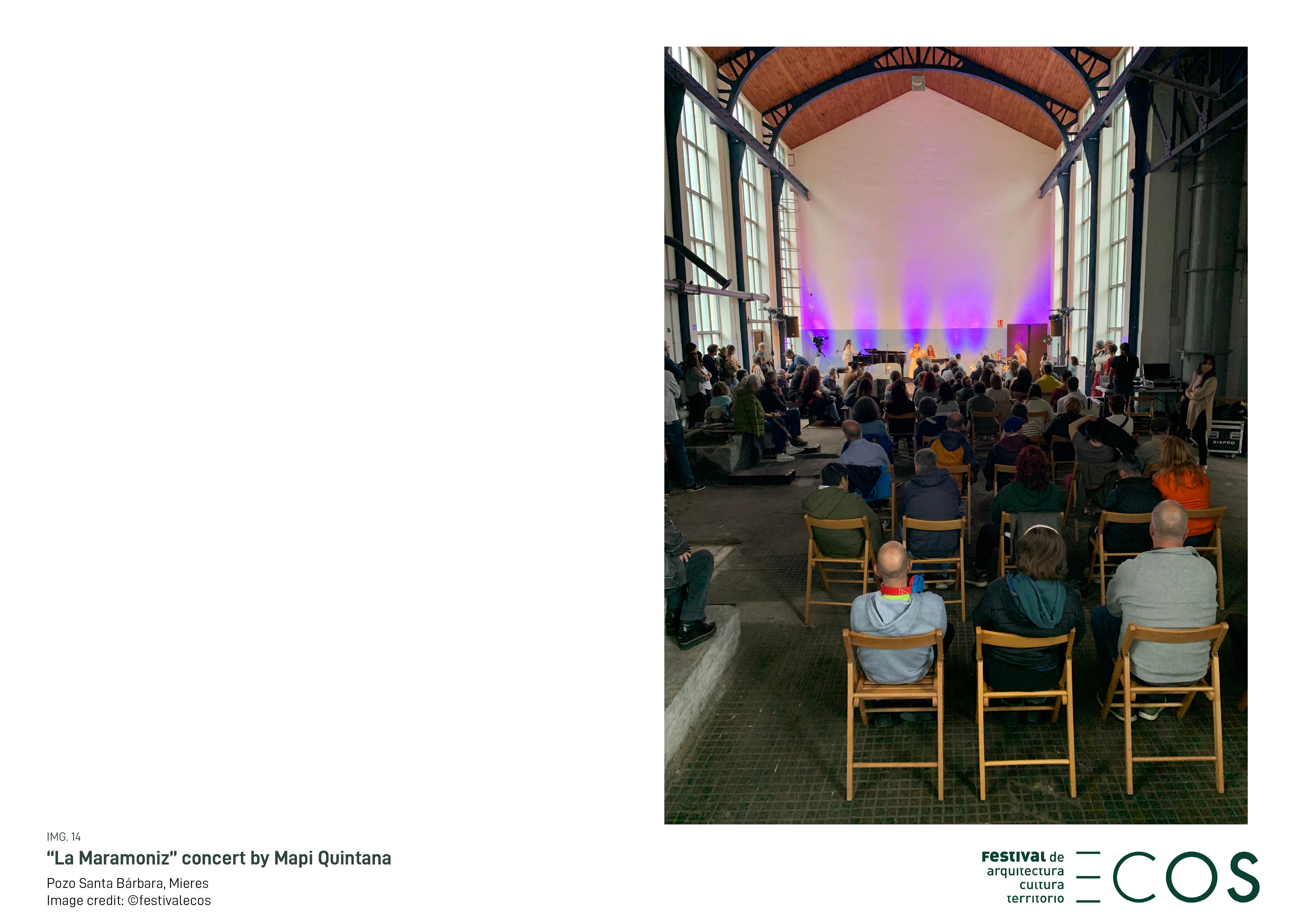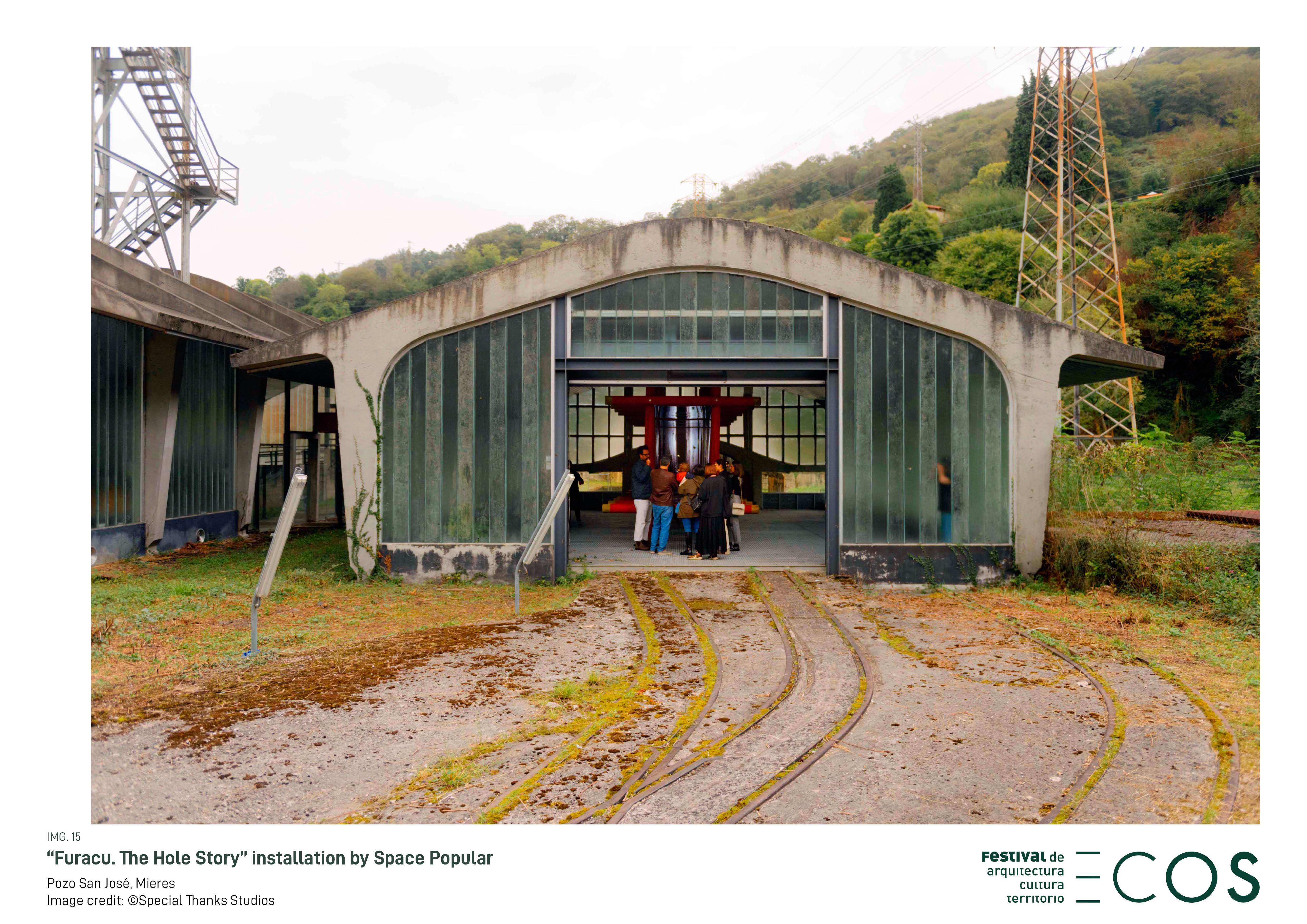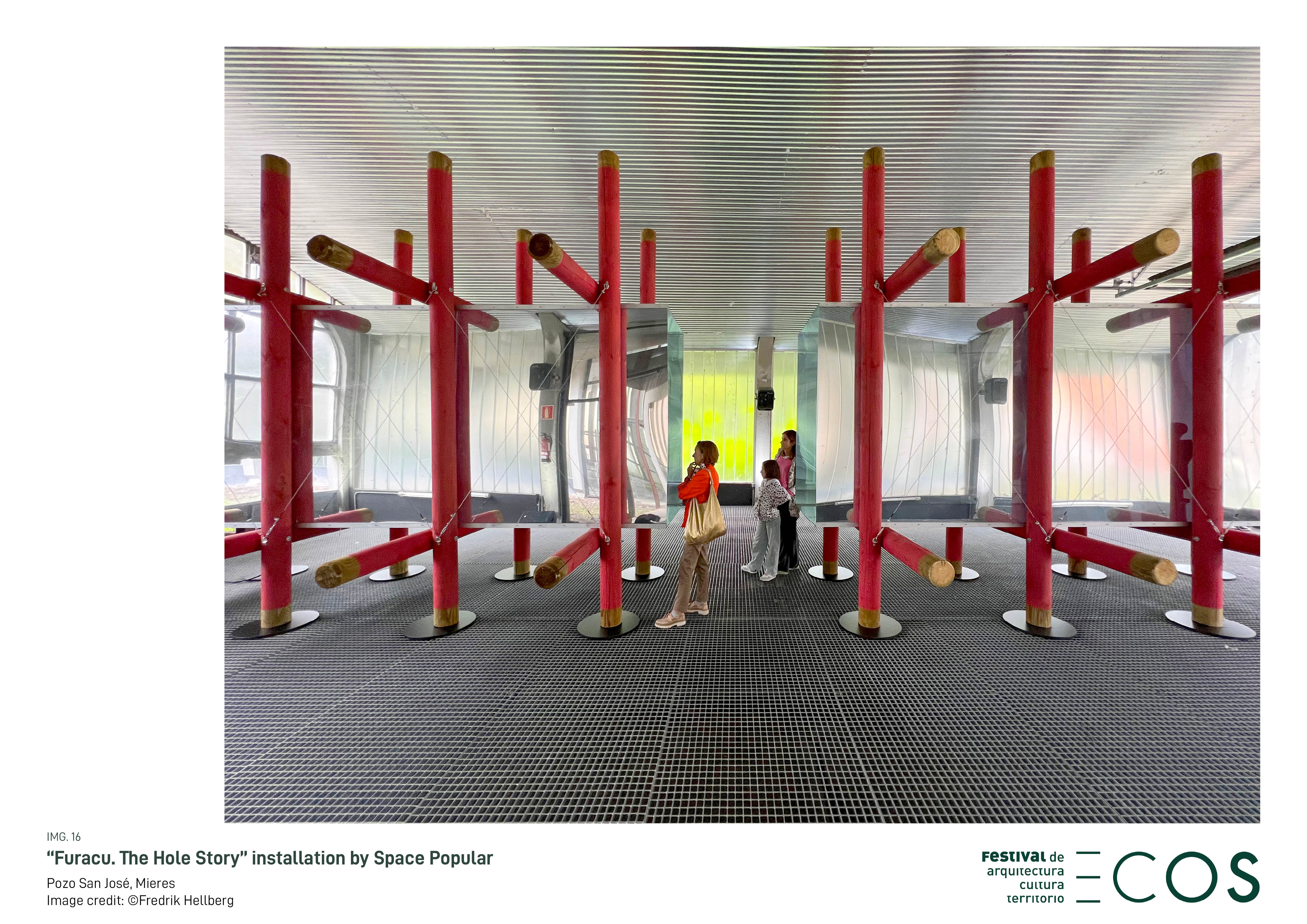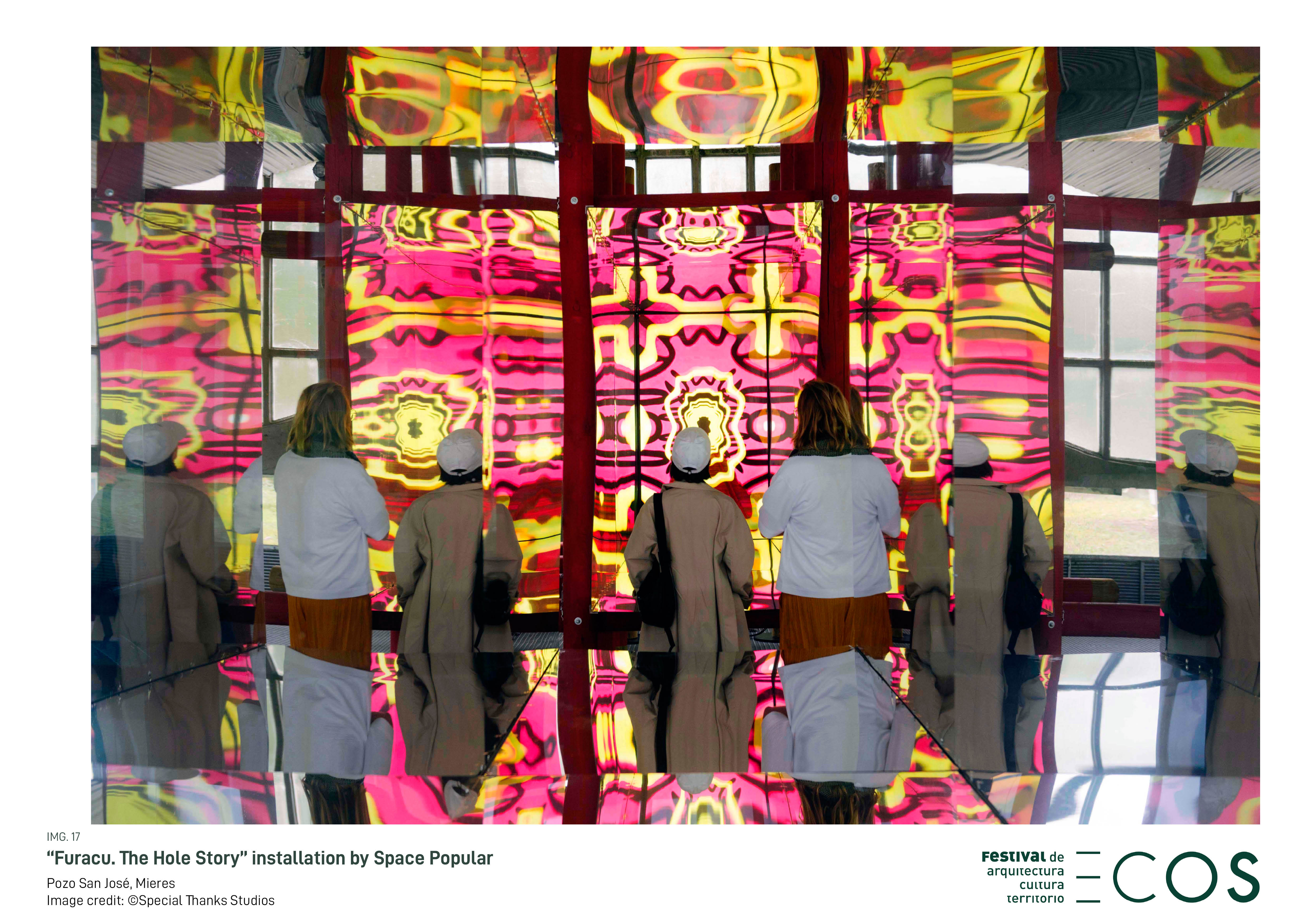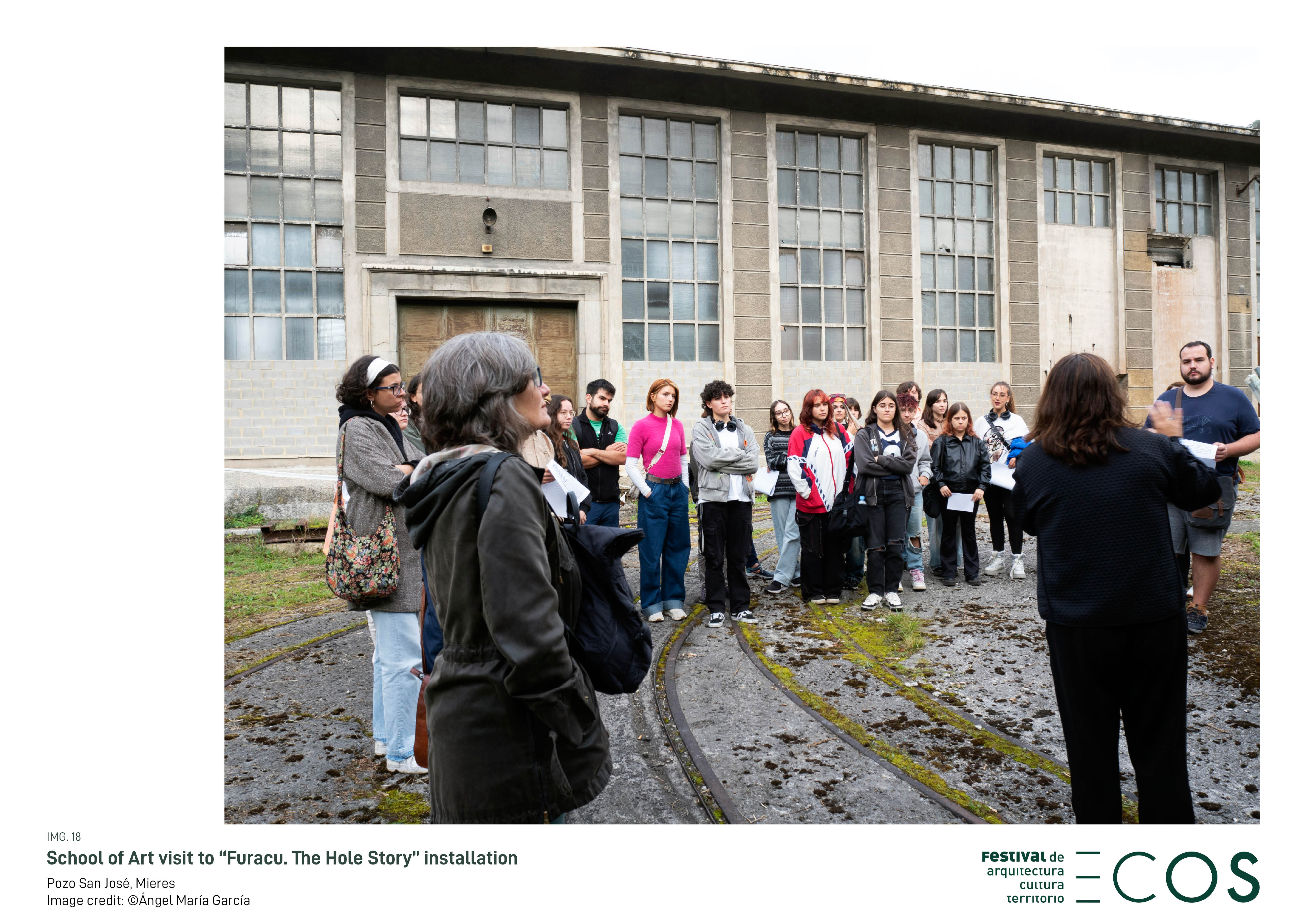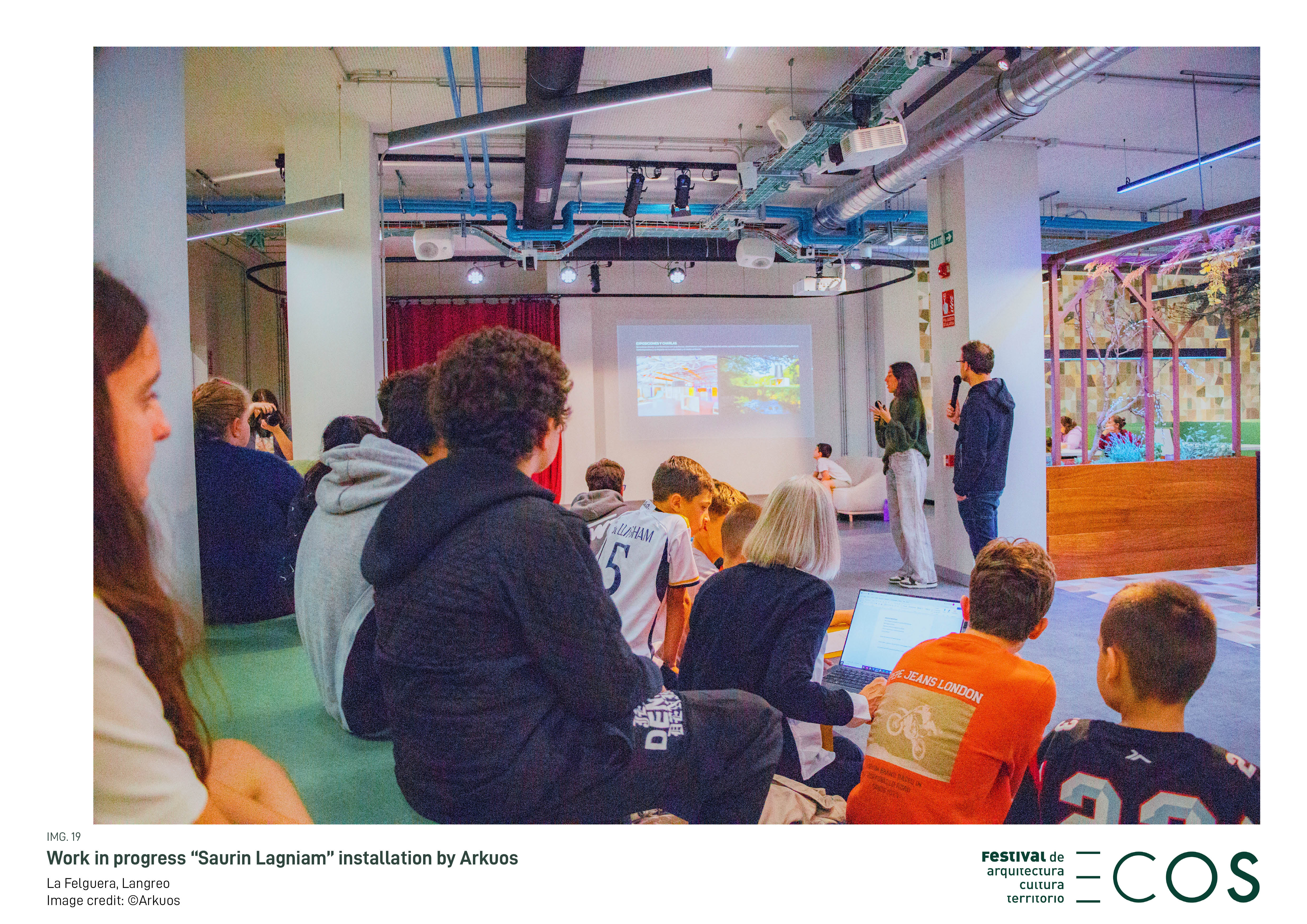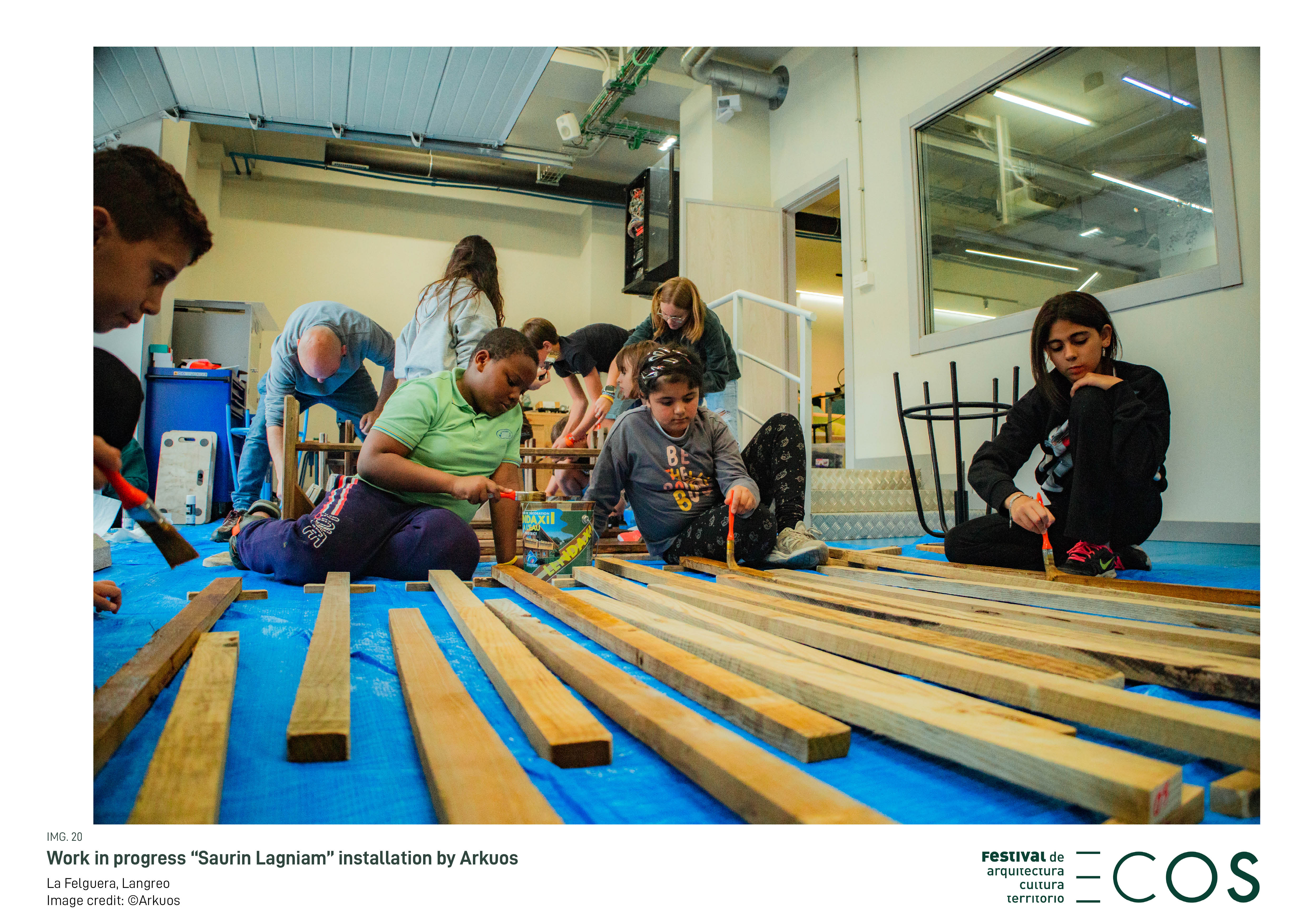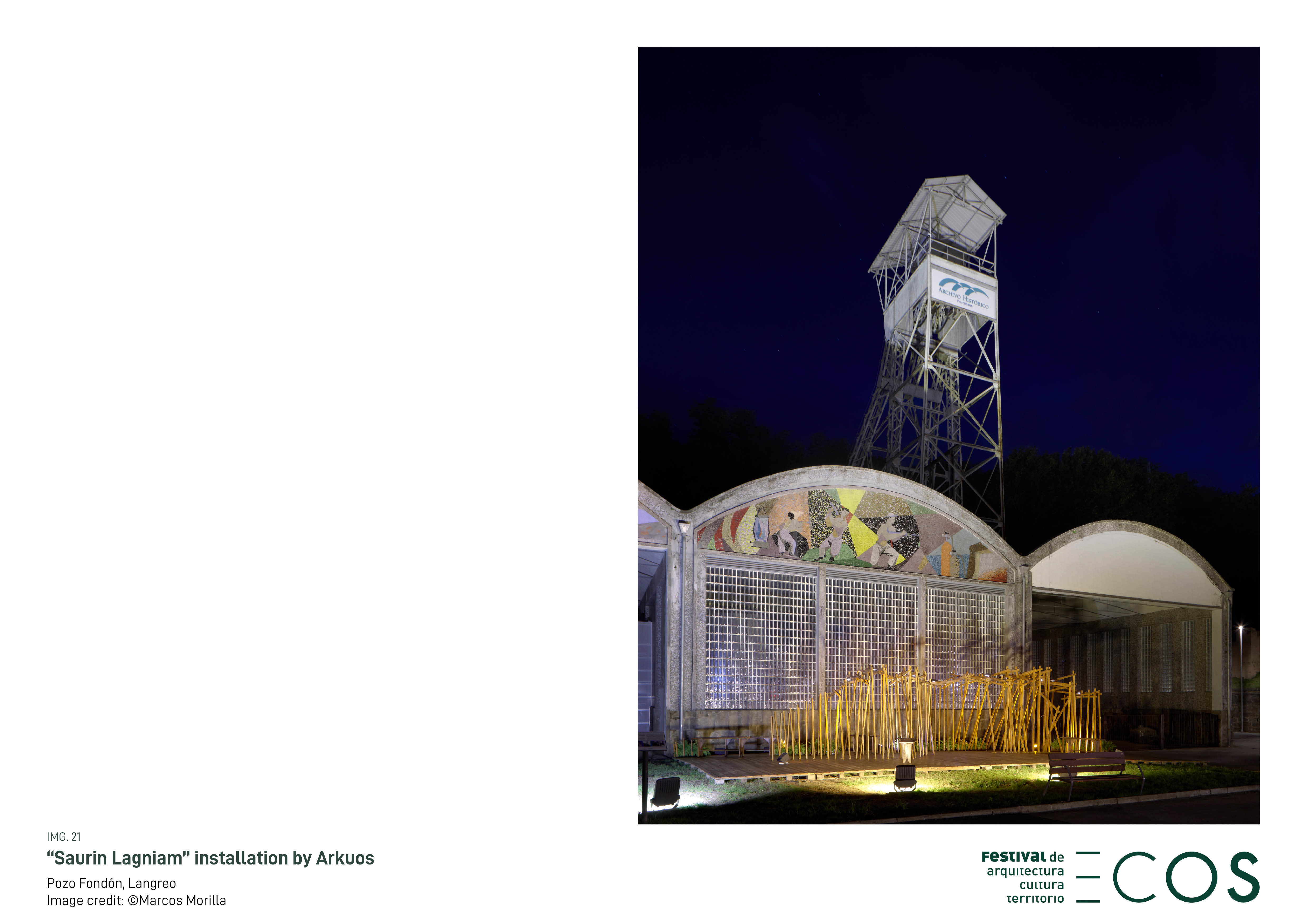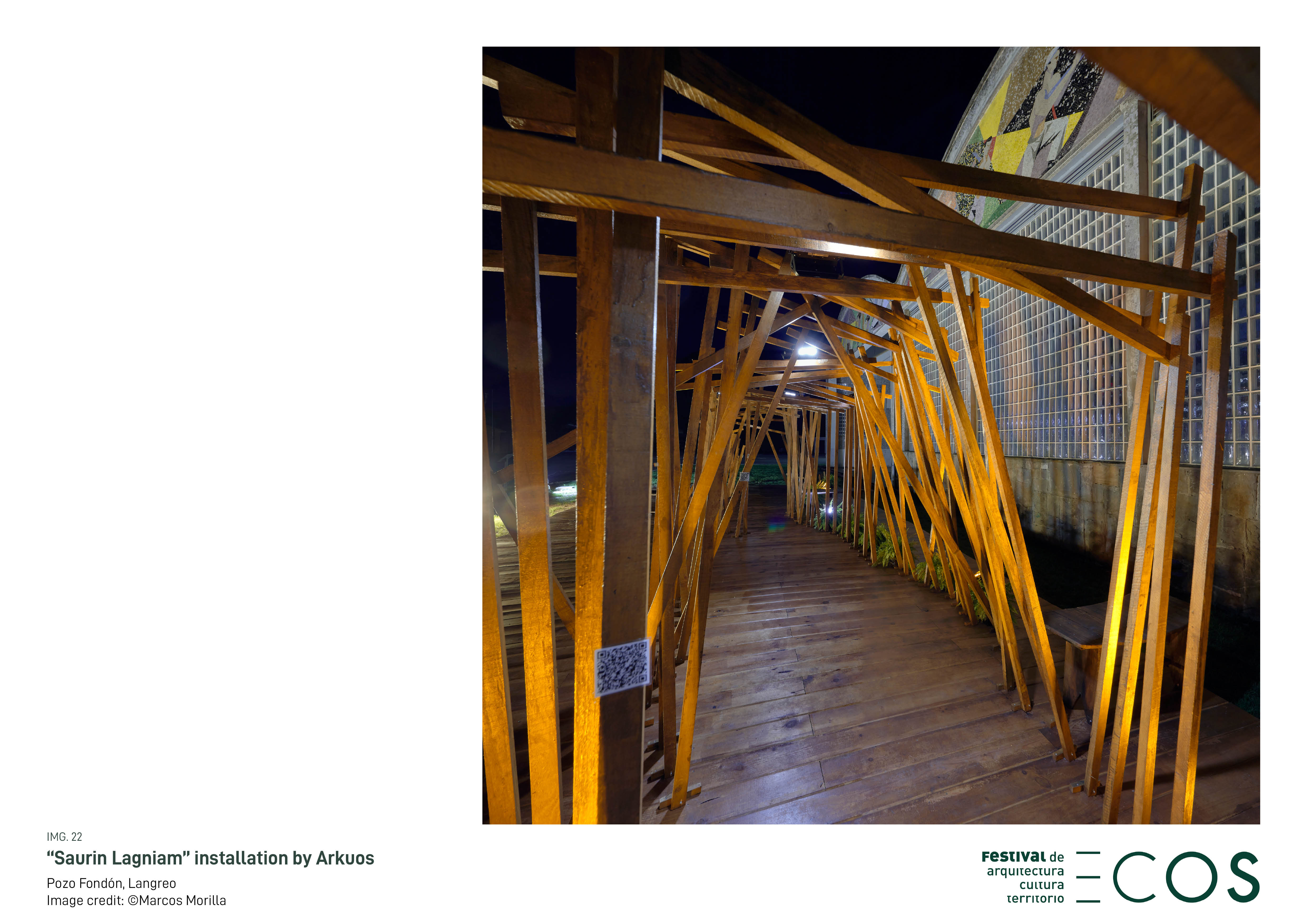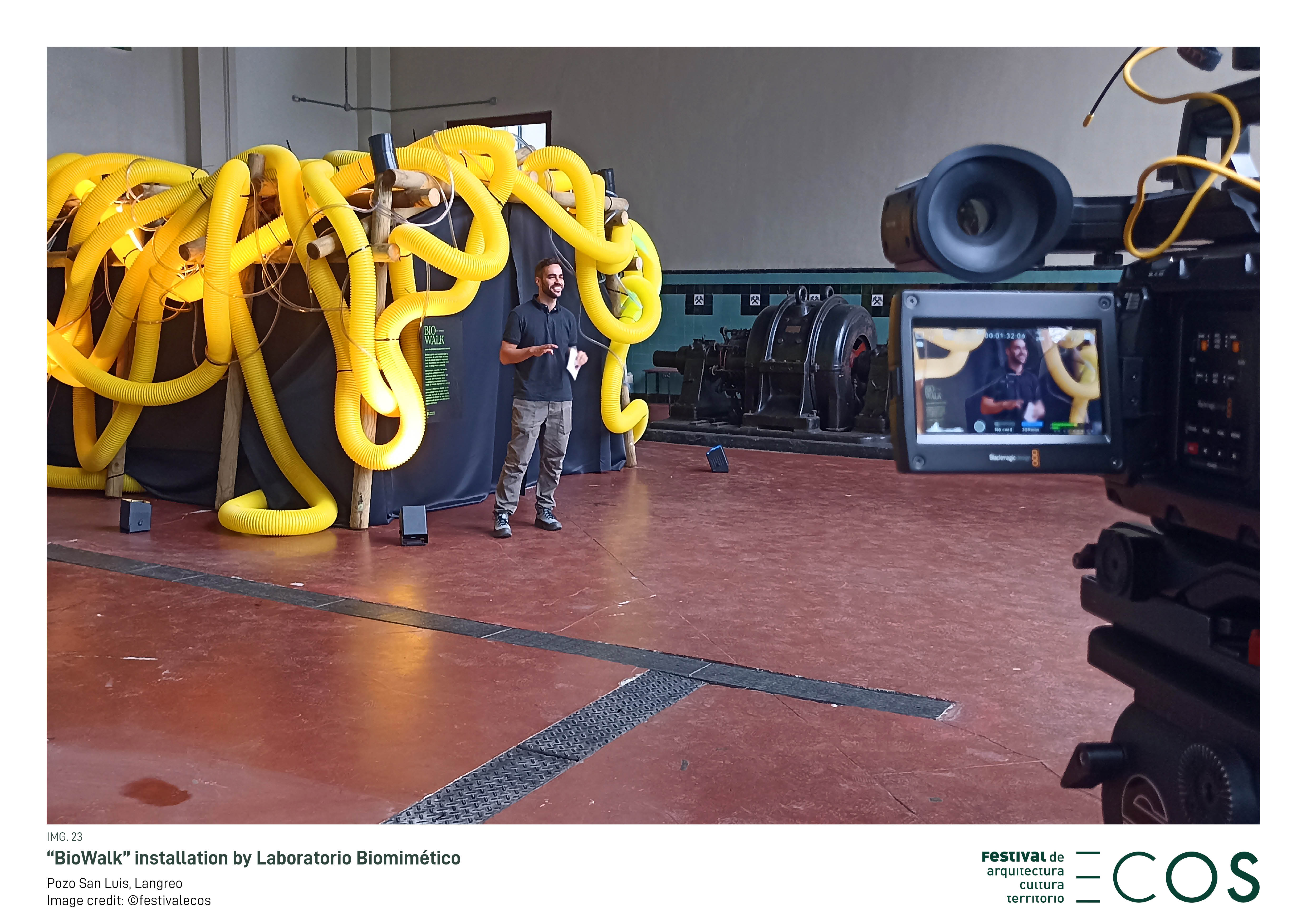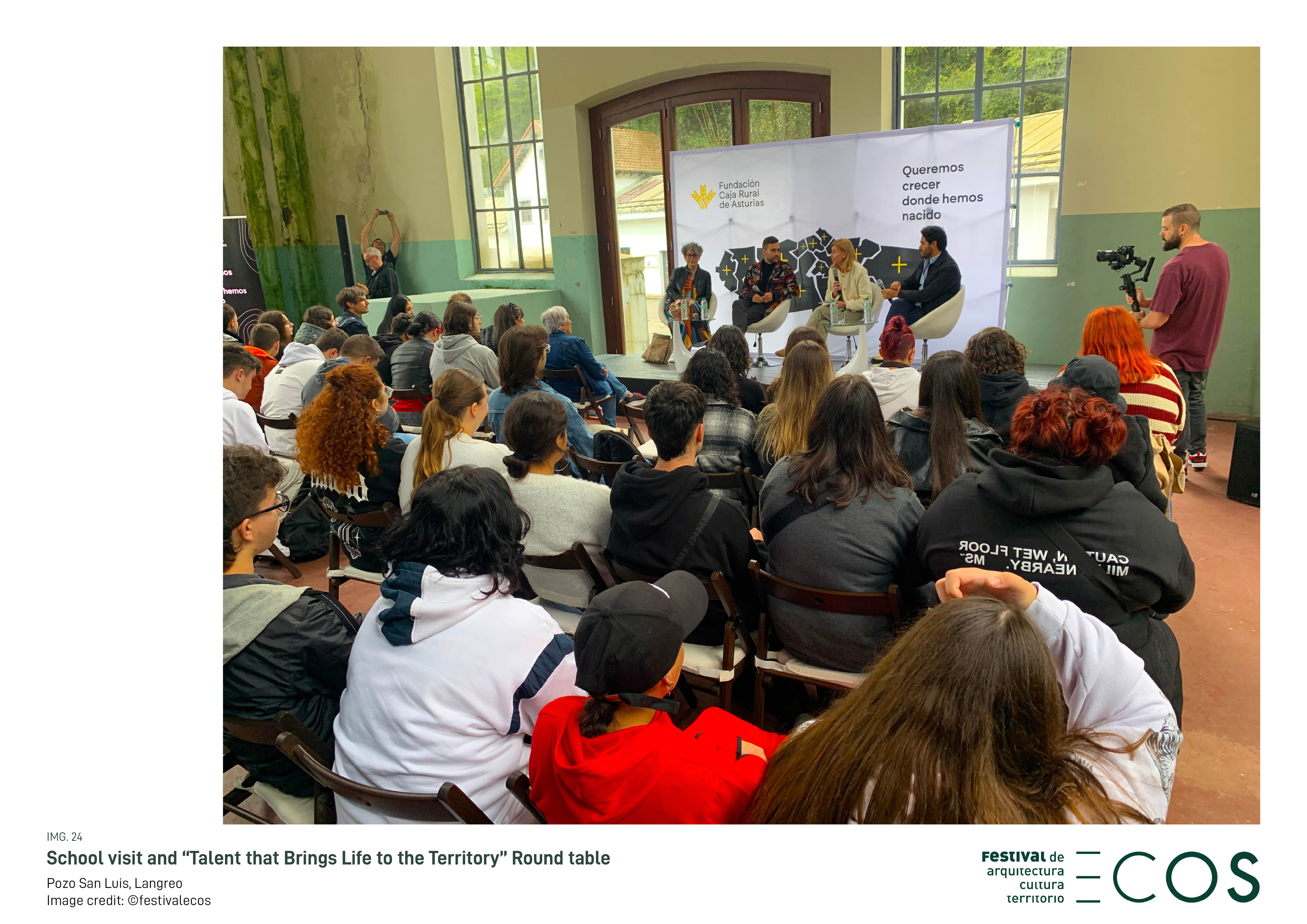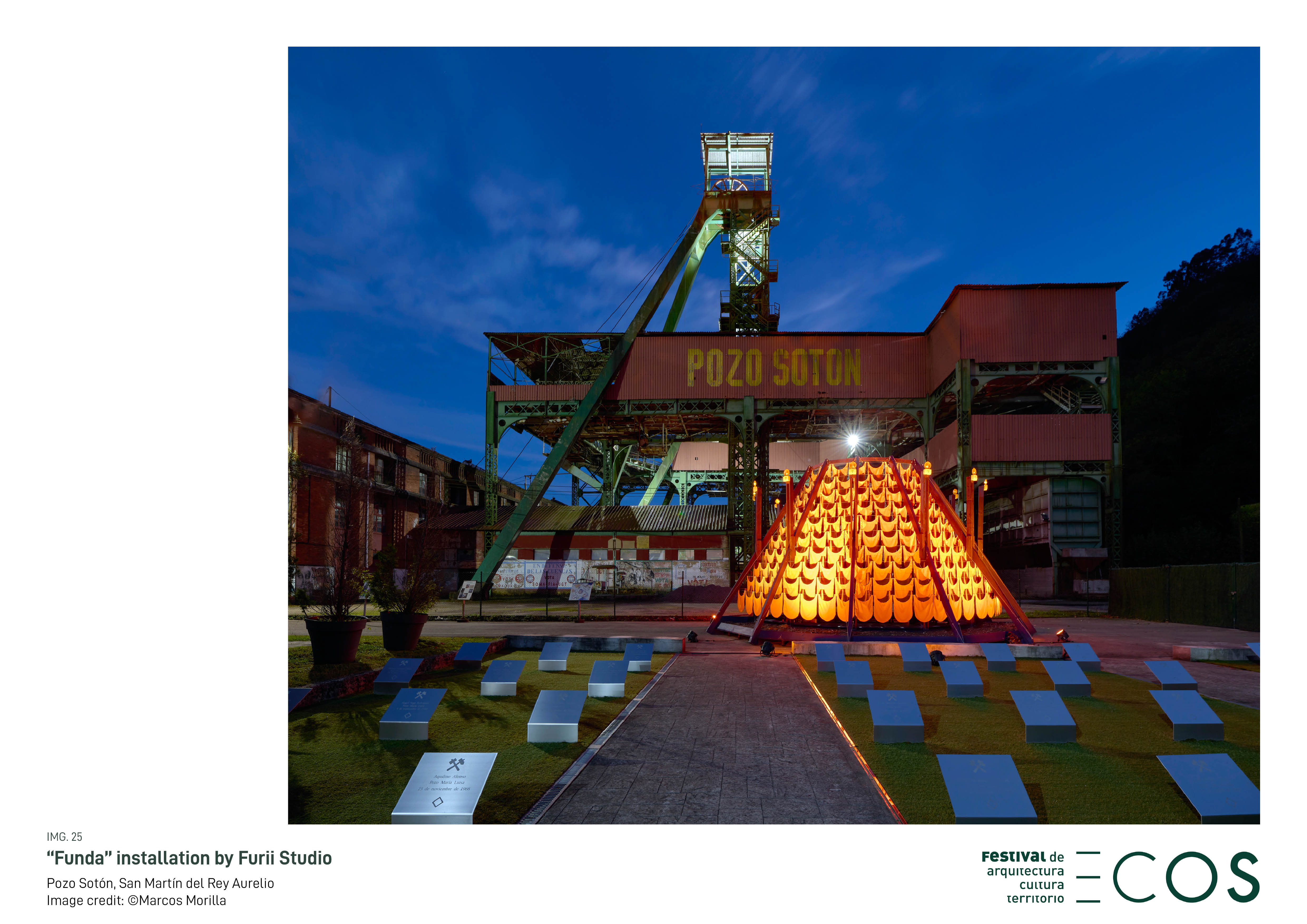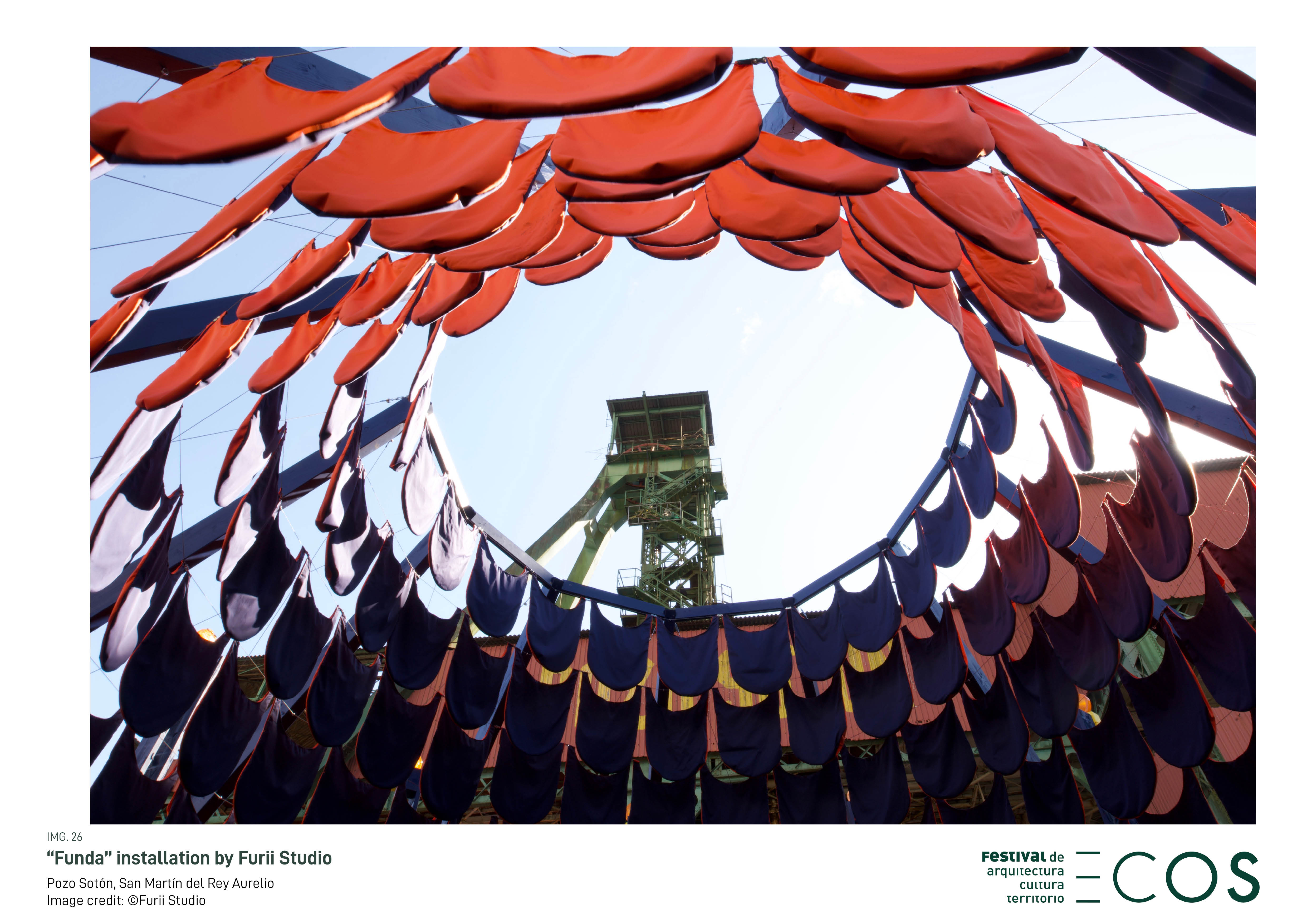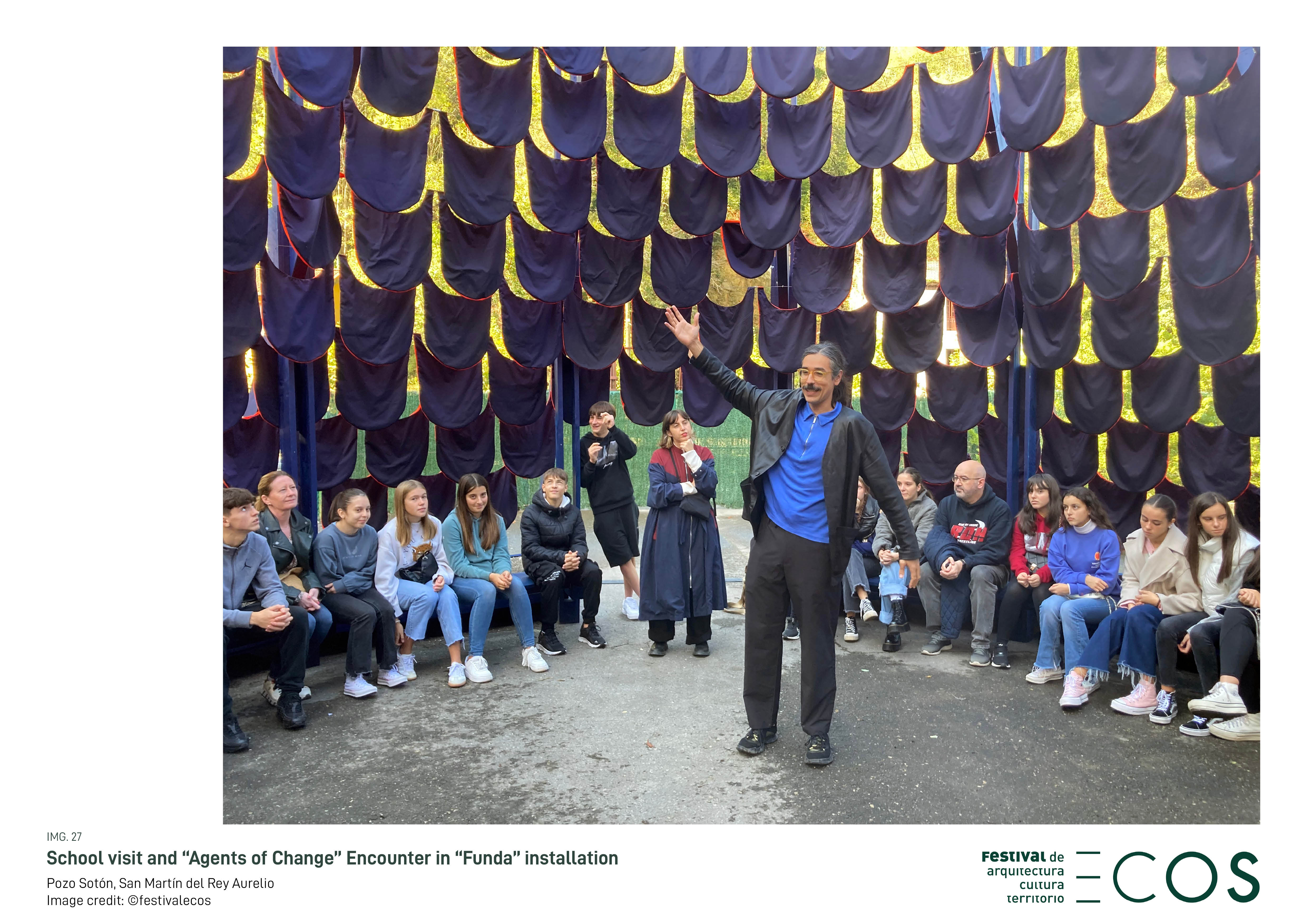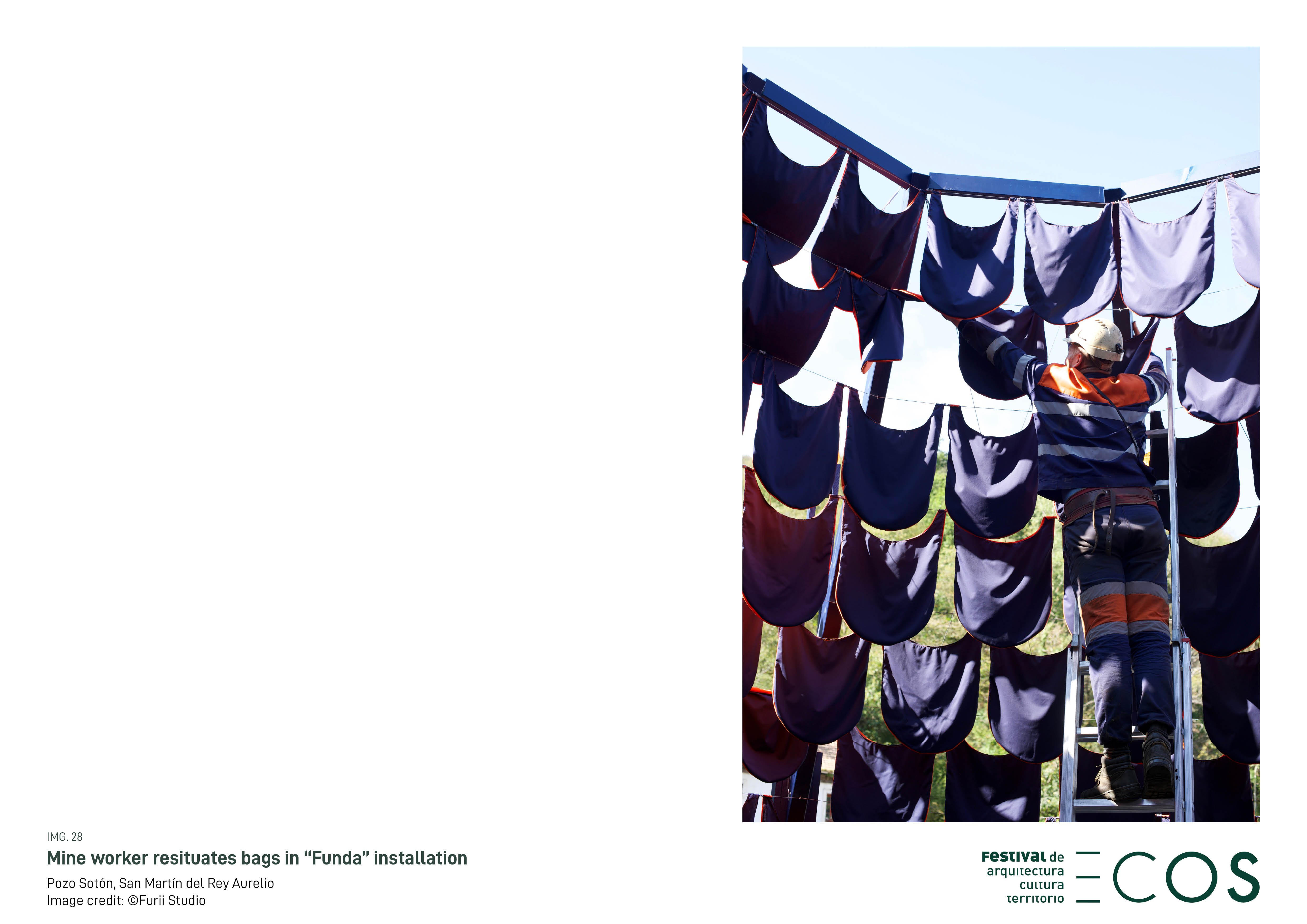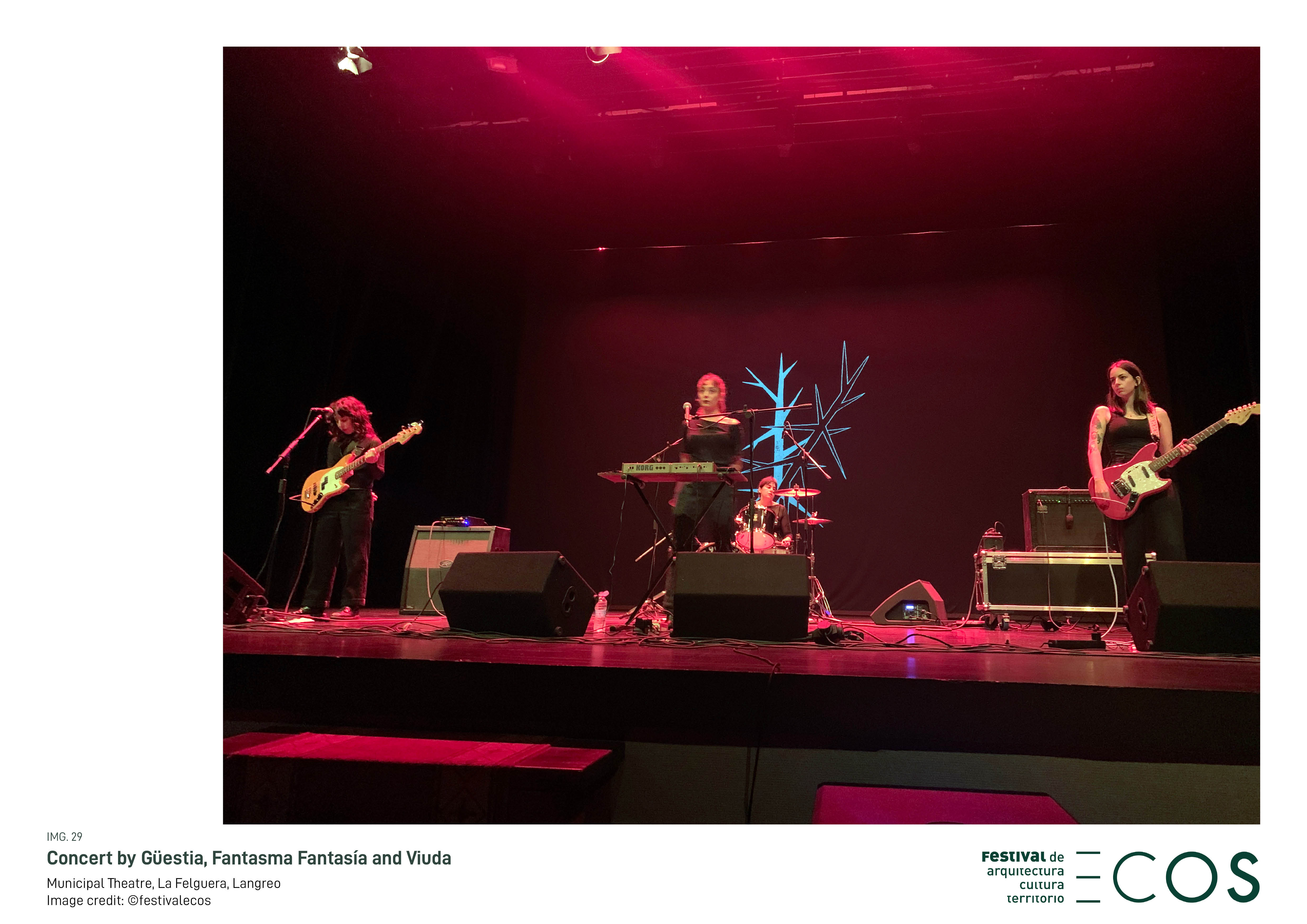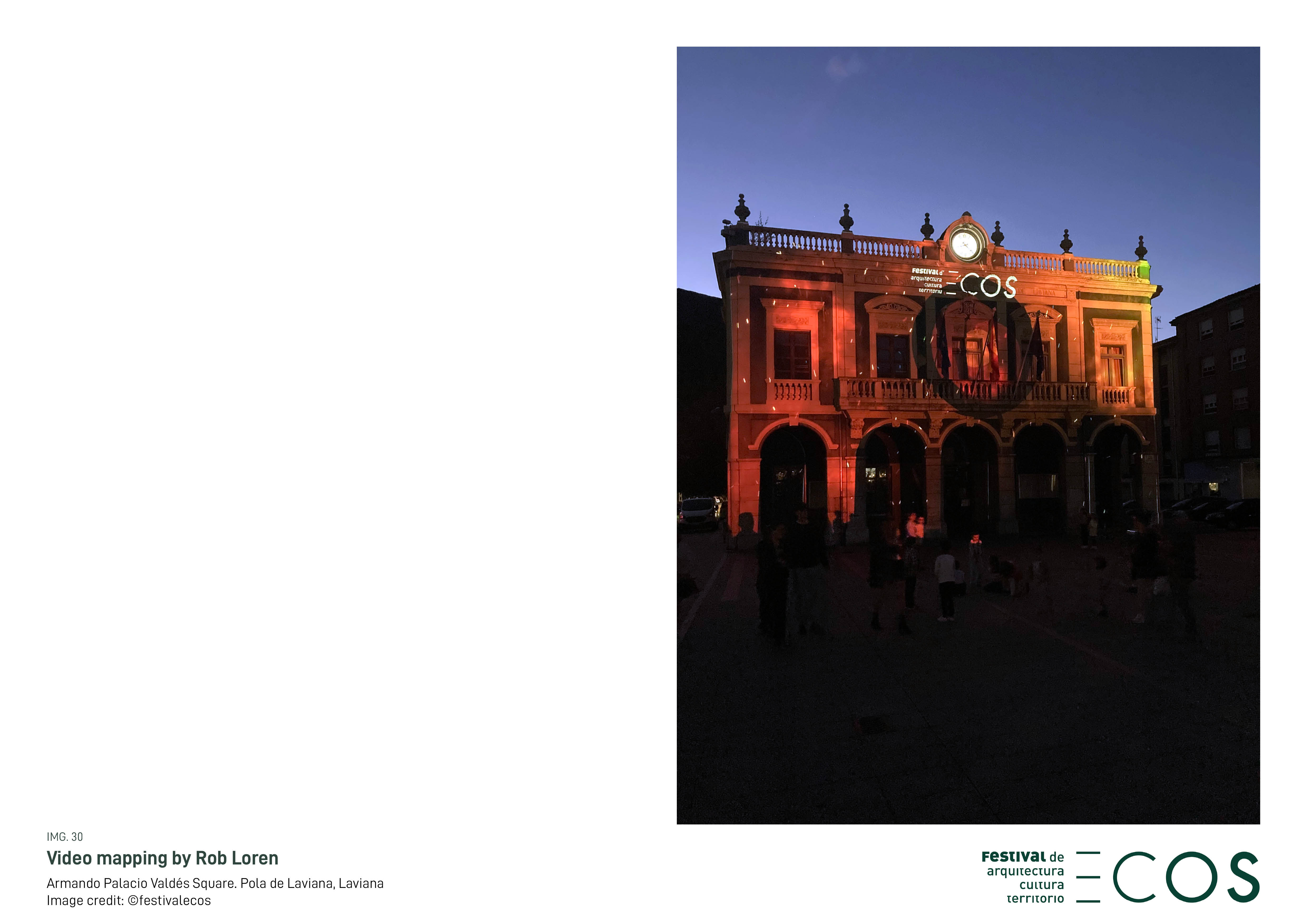Regaining a sense of belonging
ECOS
ECOS. Architecture, Culture and Territory Festival
The project aims to highlight the cultural heritage of Asturias. To this end, a series of ephemeral architecture installations are built in relation to prominent elements of the territory, linked by the common theme of Coal Mining Heritage. Alongside them, a programme of cultural and participatory activities contributes to temporarily activating the selected places.
The combined action of installations and programme fosters the interconnection between inherited memories and envisioned futures.
The combined action of installations and programme fosters the interconnection between inherited memories and envisioned futures.
Spain
Regional
Principado de Asturias
It addresses urban-rural linkages
It refers to other types of transformations (soft investment)
Yes
2024-10-13
No
No
No
As a representative of an organisation
ECOS Festival is inspired by the well-known format of the architecture festival. However, it is not celebrated in an urban setting, as accustomed, but rather finds its place in the territorial sphere.
This strategic move allows for the establishment of links with elements, constructions and knowledge belonging to the cultural heritage, whose deepest roots are scattered throughout the territory. The project connects memory and future, fostering temporary cohabitation between safeguarded heritage sites and the most contemporary architectural expression. Therefore, disparate fields of knowledge meet and reinforce each other through a series of ephemeral architecture installations, the core argument of the festival's cultural proposal.
It is conceived as a periodic and long-term initiative that aspires to be an exemplary model for the recovery and promotion of the cultural dimension of the territory. Its conceptual and organizational structure are defined around three major conceptual categories:
ARCHITECTURE: The festival illustrates the capacity of architecture as a vehicle for cultural expression. It does so through the creation of ephemeral architecture installations in selected locations with high heritage value. Renowned creative teams with both an international background and local roots are invited to design each of the installations.
CULTURE. It incorporates the architectural dimension into the existing cultural network, reinforcing and enhancing it. In addition, it addresses social and environmental challenges, and connects with younger generations by supplementing the installations with a programme of events, participatory activities, guided tours and school visits.
TERRITORY. The architectural installations and the programme are developed acknowledging the territory as our daily life setting. This conception prompts the festival to engage with local communities, respecting their past memories while suggesting future visions.
This strategic move allows for the establishment of links with elements, constructions and knowledge belonging to the cultural heritage, whose deepest roots are scattered throughout the territory. The project connects memory and future, fostering temporary cohabitation between safeguarded heritage sites and the most contemporary architectural expression. Therefore, disparate fields of knowledge meet and reinforce each other through a series of ephemeral architecture installations, the core argument of the festival's cultural proposal.
It is conceived as a periodic and long-term initiative that aspires to be an exemplary model for the recovery and promotion of the cultural dimension of the territory. Its conceptual and organizational structure are defined around three major conceptual categories:
ARCHITECTURE: The festival illustrates the capacity of architecture as a vehicle for cultural expression. It does so through the creation of ephemeral architecture installations in selected locations with high heritage value. Renowned creative teams with both an international background and local roots are invited to design each of the installations.
CULTURE. It incorporates the architectural dimension into the existing cultural network, reinforcing and enhancing it. In addition, it addresses social and environmental challenges, and connects with younger generations by supplementing the installations with a programme of events, participatory activities, guided tours and school visits.
TERRITORY. The architectural installations and the programme are developed acknowledging the territory as our daily life setting. This conception prompts the festival to engage with local communities, respecting their past memories while suggesting future visions.
Cultural Heritage
Ephemeral Architecture
Interdisciplinary event
Participatory activities
Community engagement
Consideration for sustainability and environmental impact was a fundamental pillar in the production of the architecture installations. A comprehensive approach has been promoted to transcend their fleeting presence. The creative teams were encouraged to address the reflection on the life cycle of the materials and systems used, as well as their future destination, as part of the design process. In other words, the “before” and “after” of the used resources had to be considered.
With regard to the “before”, the organization of the festival made available sustainable products from material banks, provided by collaborating companies, to be used in the construction of the installations. Consequently, most of them used a considerable proportion of traceable, reused or recycled resources. With regard to the “after”, some of the installations are kept or transported to new locations, whereas the materials from the dismantled ones have been brought back to their original source, are stored for future recycling and reuse, or have been transferred to waste management plants.
Furthermore, one of the installations, was resulting from a summerschool which combined architectural theory and practice around the themes of rural depopulation, the evolution of the post-industrial territory and the learning of sustainable construction techniques using wood, straw and raw earth. It was open to international architecture students and any professional interested in the subject under the supervision of a team of experts in green construction and architecture teachers from various European universities.
The aim was not only to be exemplary, but also educational in compliance with sustainability and energy efficiency criteria. This commitment to sustainability seeks not only to minimise the impact during the event, but also to leave a positive legacy in the environment after its conclusion.
With regard to the “before”, the organization of the festival made available sustainable products from material banks, provided by collaborating companies, to be used in the construction of the installations. Consequently, most of them used a considerable proportion of traceable, reused or recycled resources. With regard to the “after”, some of the installations are kept or transported to new locations, whereas the materials from the dismantled ones have been brought back to their original source, are stored for future recycling and reuse, or have been transferred to waste management plants.
Furthermore, one of the installations, was resulting from a summerschool which combined architectural theory and practice around the themes of rural depopulation, the evolution of the post-industrial territory and the learning of sustainable construction techniques using wood, straw and raw earth. It was open to international architecture students and any professional interested in the subject under the supervision of a team of experts in green construction and architecture teachers from various European universities.
The aim was not only to be exemplary, but also educational in compliance with sustainability and energy efficiency criteria. This commitment to sustainability seeks not only to minimise the impact during the event, but also to leave a positive legacy in the environment after its conclusion.
Most of the installations have been designed by creative teams with a distinguished international track record and local roots, but who were not very well known in the region. Their participation gives visibility to practices whose work has mainly been carried out, and therefore noticed, in foreign contexts. They claim an unoccupied space in a region lacking initiatives operating on the cultural dimension of architecture.
Each site housed an ephemeral architecture installation designed specifically for the festival and to be easily executed and dismantled. The task given to the creative teams was to establish dialogue with the heritage element where their installation was to be located, activating the space and its memory, in order to reveal, enhance or confront its architectural, historical, cultural or social attributes.
Ultimately, the festival leveraged architecture as a platform to showcase and celebrate diverse cultural expressions, including music, literature, filmmaking, and videomapping. Its programme was designed to achieve both territorial and generational balance, integrating activities that drew inspiration from local traditions alongside innovative formats. This approach fostered a meaningful dialogue between heritage and modernity, bridging past and present through artistic and cultural exchange. The challenge of mobilising the public throughout the territory was addressed by implementing a calendar of guided and school visits, to which public transport was provided. A QR code placed at each of the festival locations gave easy access to audio guides describing the cultural values of the place and the purpose of the installation.
Finally, the festival benefited from the unique landscape and heritage sites of Asturias, which renders a remarkable background where the installations are integrated, the events take place and the activities find room, differentiating itself from similar initiatives of a more urban character.
Each site housed an ephemeral architecture installation designed specifically for the festival and to be easily executed and dismantled. The task given to the creative teams was to establish dialogue with the heritage element where their installation was to be located, activating the space and its memory, in order to reveal, enhance or confront its architectural, historical, cultural or social attributes.
Ultimately, the festival leveraged architecture as a platform to showcase and celebrate diverse cultural expressions, including music, literature, filmmaking, and videomapping. Its programme was designed to achieve both territorial and generational balance, integrating activities that drew inspiration from local traditions alongside innovative formats. This approach fostered a meaningful dialogue between heritage and modernity, bridging past and present through artistic and cultural exchange. The challenge of mobilising the public throughout the territory was addressed by implementing a calendar of guided and school visits, to which public transport was provided. A QR code placed at each of the festival locations gave easy access to audio guides describing the cultural values of the place and the purpose of the installation.
Finally, the festival benefited from the unique landscape and heritage sites of Asturias, which renders a remarkable background where the installations are integrated, the events take place and the activities find room, differentiating itself from similar initiatives of a more urban character.
The festival strongly emphasized community involvement, with local communities actively participating in programming, development, and coordination of several of its activities. This fostered a sense of belonging and cultural exchange, strengthening connections with the festival’s surroundings and extending its impact beyond scheduled dates. It also provided visibility to local groups and opportunities for broader engagement.
By involving both local and international creators, the festival promoted cross-cultural collaboration, enriching its offerings with diverse perspectives and practices. Community-driven events ensured the active participation of various groups, fostering cultural inclusivity and mutual understanding. Ultimately, it became a space where cultural identities were celebrated, shared, and redefined in a global dialogue.
The festival’s conceptual strategy identified two primary target groups: local communities and youth. Several initiatives were designed to engage them, the most significant being the involvement of young participants from Arkuos, a local socio-educational space. They were given responsibility for the installations located in Pozo Fondón, which resulted in a project fully conceived and built by over 60 contributors aged eight to their early twenties.
Another key initiative was the collaboration of Fundación Laboral Santa Bárbara, a local non-profit organization supporting individuals with disabilities, in the installation at Pozo Sotón. Participants created colorful bags for the pavilion, demonstrating how inclusion can be realized through co-creation and collaborative design.
By involving both local and international creators, the festival promoted cross-cultural collaboration, enriching its offerings with diverse perspectives and practices. Community-driven events ensured the active participation of various groups, fostering cultural inclusivity and mutual understanding. Ultimately, it became a space where cultural identities were celebrated, shared, and redefined in a global dialogue.
The festival’s conceptual strategy identified two primary target groups: local communities and youth. Several initiatives were designed to engage them, the most significant being the involvement of young participants from Arkuos, a local socio-educational space. They were given responsibility for the installations located in Pozo Fondón, which resulted in a project fully conceived and built by over 60 contributors aged eight to their early twenties.
Another key initiative was the collaboration of Fundación Laboral Santa Bárbara, a local non-profit organization supporting individuals with disabilities, in the installation at Pozo Sotón. Participants created colorful bags for the pavilion, demonstrating how inclusion can be realized through co-creation and collaborative design.
Building on previously mentioned examples, we may argue that the project incorporated participatory processes at three levels: consultation, co-development, and self-governance.
At the consultation level, experts in green construction and architecture professors from various European universities guided the international summerschool, providing students and professionals with hands-on experience in sustainable building techniques. The initiative not only enriched participants' knowledge but also contributed to discussions on rural depopulation and post-industrial landscapes, reinforcing a commitment to sustainability.
Co-development and self-governance was a key element in engaging local communities and youth. The festival actively involved young participants from Arkuos, giving them responsibility for the installation at Pozo Fondón. They demonstrated creativity and ownership in their design and construction, getting empowerment by hands-on learning in a real-world architectural setting.
They also were exemplified through the collaboration with the local non-profit organization Fundación Laboral Santa Bárbara. Its workers, local people with disabilities, created the colorful bags for the installation at Pozo Sotón, demonstrating how inclusive design can empower participants by giving them a direct role in shaping the festival’s outcomes.
Therefore, the festival invited experts, students, and diverse community members to become co-creators of the initiative, consolidating its collective and educational ambition to build up together a meaningful and lasting legacy.
At the consultation level, experts in green construction and architecture professors from various European universities guided the international summerschool, providing students and professionals with hands-on experience in sustainable building techniques. The initiative not only enriched participants' knowledge but also contributed to discussions on rural depopulation and post-industrial landscapes, reinforcing a commitment to sustainability.
Co-development and self-governance was a key element in engaging local communities and youth. The festival actively involved young participants from Arkuos, giving them responsibility for the installation at Pozo Fondón. They demonstrated creativity and ownership in their design and construction, getting empowerment by hands-on learning in a real-world architectural setting.
They also were exemplified through the collaboration with the local non-profit organization Fundación Laboral Santa Bárbara. Its workers, local people with disabilities, created the colorful bags for the installation at Pozo Sotón, demonstrating how inclusive design can empower participants by giving them a direct role in shaping the festival’s outcomes.
Therefore, the festival invited experts, students, and diverse community members to become co-creators of the initiative, consolidating its collective and educational ambition to build up together a meaningful and lasting legacy.
Even though the festival was an initiative promoted by the public administration, it was envisioned as a collective endeavor enriched by the collaboration of multiple agents: other regional and local administrations, varied institutions which mission comprises architectural, cultural or territorial objectives, as well as those closely related to Industrial Mining Heritage, which were invited to contribute in various ways.
The main challenge consisted of coordinating their participation. Some helped in the organization and financial support of activities included in the programme, while others assisted by addressing logistical needs. In particular cases, collaborating institutions were invited to take care of one specific event in one specific date at one specific location.
Collectively, all these entities are recognized as associated institutions. They include: Ayuntamiento de Langreo, Ayuntamiento de Mieres, Ayuntamiento de San Martín del Rey Aurelio, Ayuntamiento de Laviana, Ayuntamiento de Aller, HUNOSA, Ecomuseo de Samuño, Fundación Caja Rural, Colegio Oficial de Arquitectos de Asturias, Universidad de Oviedo, Fundación Laboral de la Construcción, Ayuntamiento de Soto del Barco, LABoral Centro de Arte y Producción Industrial, Fundación Laboral de la Construcción, Fundación Cruz de los Ángeles and Cetemas.
Besides, the organization team of the festival was composed by twenty-six people, including architects, economists, art historians, journalists, designers, marketing experts, media experts, cultural managers, photographers, and students. Regarding the participants in the design of the installations and the activities programme, we may find: creative teams, architects, artists, musicians, filmmakers, writers, entrepreneurs, and all the people involved in the management and development of its various locations. The festival was possible thanks to all these contributions.
The main challenge consisted of coordinating their participation. Some helped in the organization and financial support of activities included in the programme, while others assisted by addressing logistical needs. In particular cases, collaborating institutions were invited to take care of one specific event in one specific date at one specific location.
Collectively, all these entities are recognized as associated institutions. They include: Ayuntamiento de Langreo, Ayuntamiento de Mieres, Ayuntamiento de San Martín del Rey Aurelio, Ayuntamiento de Laviana, Ayuntamiento de Aller, HUNOSA, Ecomuseo de Samuño, Fundación Caja Rural, Colegio Oficial de Arquitectos de Asturias, Universidad de Oviedo, Fundación Laboral de la Construcción, Ayuntamiento de Soto del Barco, LABoral Centro de Arte y Producción Industrial, Fundación Laboral de la Construcción, Fundación Cruz de los Ángeles and Cetemas.
Besides, the organization team of the festival was composed by twenty-six people, including architects, economists, art historians, journalists, designers, marketing experts, media experts, cultural managers, photographers, and students. Regarding the participants in the design of the installations and the activities programme, we may find: creative teams, architects, artists, musicians, filmmakers, writers, entrepreneurs, and all the people involved in the management and development of its various locations. The festival was possible thanks to all these contributions.
The core argument of the initiative was to highlight the potential architecture has to modify the perception of an inherited place, both conceptually and emotionally. Consequently, architecture was the pivotal discipline within a programme that involved many other creative dimensions.
However, each of the participating architecture practices has a particular approach to relevant subjects such as heritage, sustainability, or society, which resulted in a very diverse array of installations. We considered their different standpoints as an opportunity to celebrate the assemblage of contemporary, committed and refreshing architectural visions. In fact, some of the teams are working trans-disciplinary, showing how novel architecture can be fruitfully enriched by its interaction with virtual media, biomimetic design, or music. Several round tables discussing relevant topics were organized giving them the opportunity to share, discuss and confront their approaches.
However, each of the participating architecture practices has a particular approach to relevant subjects such as heritage, sustainability, or society, which resulted in a very diverse array of installations. We considered their different standpoints as an opportunity to celebrate the assemblage of contemporary, committed and refreshing architectural visions. In fact, some of the teams are working trans-disciplinary, showing how novel architecture can be fruitfully enriched by its interaction with virtual media, biomimetic design, or music. Several round tables discussing relevant topics were organized giving them the opportunity to share, discuss and confront their approaches.
In recent years, alternative formulas for architectural creation and dissemination, democratising its discourse and transmitting its values to general public, have emerged. Thanks to them, its influence has extended to places that have been plunged into inactivity or oblivion.
The architecture festival, a relatively recent format, is one of them. It is aimed at celebrating and promoting architecture in its various forms, offering a platform for architects, designers, urban planners and creative enthusiasts to share ideas, experiences and projects. They can also include a wide range of activities such as temporary installations, conferences, talks, roundtables, exhibitions, architectural tours, workshops and social events. Festivals are valuable opportunities to inspire, educate and foster collaboration between professionals and the general public, as well as promoting the positive impact that architecture can have on our lives and local communities.
As mentioned above, the project is inspired on this well-known format. However, it is not celebrated in an urban setting, as accustomed, but rather finds its place across the territory. Introducing the festival format on cultural heritage sites provides significant benefits. It complies with the need to acknowledge the cultural dimension of architecture as part of the identity of a place or community; reveals the potential of inherited legacy to accommodate future developments; and provides a spatial platform for other contemporary cultural expressions.
Furthermore, each of the editions of the festival is planned to have a thematic axis, determining the locations and its programme of activities. After successive editions, and their varied themes and events, it is expected to become a cohesive element of the cultural network at a territorial scale, activating its different layers and contributing to consolidate, over time, a varied offer of cultural circuits throughout the region.
The architecture festival, a relatively recent format, is one of them. It is aimed at celebrating and promoting architecture in its various forms, offering a platform for architects, designers, urban planners and creative enthusiasts to share ideas, experiences and projects. They can also include a wide range of activities such as temporary installations, conferences, talks, roundtables, exhibitions, architectural tours, workshops and social events. Festivals are valuable opportunities to inspire, educate and foster collaboration between professionals and the general public, as well as promoting the positive impact that architecture can have on our lives and local communities.
As mentioned above, the project is inspired on this well-known format. However, it is not celebrated in an urban setting, as accustomed, but rather finds its place across the territory. Introducing the festival format on cultural heritage sites provides significant benefits. It complies with the need to acknowledge the cultural dimension of architecture as part of the identity of a place or community; reveals the potential of inherited legacy to accommodate future developments; and provides a spatial platform for other contemporary cultural expressions.
Furthermore, each of the editions of the festival is planned to have a thematic axis, determining the locations and its programme of activities. After successive editions, and their varied themes and events, it is expected to become a cohesive element of the cultural network at a territorial scale, activating its different layers and contributing to consolidate, over time, a varied offer of cultural circuits throughout the region.
The festival’s conceptual approach as a cultural activity on a territorial scale, as well as the chosen locations, is inspired by prior research projects that involved the project’s leadership participation. These include: Conceptual Actions in the Landscape (https://raal.es/en/acciones-conceptuales-en-el-paisaje/), Asturian Mining Landscape (https://raal.es/en/paisaje-minero-de-asturias/), Echoes of Immensity (https://raal.es/en/ecos-de-la-inmensidad-castilletes-mineros-de-asturias/), and especially Learning from Las Cuencas (https://raal.es/en/aprendiendo-de-las-cuencas/, https://raal.es/en/learning-from-las-cuencas-the-book/), which received the Europa Nostra Award in the Research category in 2015.
The first edition of the festival ended in October 2024. It became an event with its own space within the regional cultural agenda, defined by a vision, a corporate image, a website, and presence in social media. Now, it faces a new period that involves consolidating its organizational structure and renovating the economic support. According to the strategic plan of the festival, it has been proposed the creation of a scientific committee formed by experts in fields related to architecture, territory and culture. The committee will be responsible for providing advice and approval on relevant aspects of the event. Its tasks include the definition of a main theme for each edition, the selection of its locations and the validation of the programme. The constellation of alliances built around the first edition sets the basis for obtaining logistical and organizational support toward the formulation of future editions.
The first edition of the festival ended in October 2024. It became an event with its own space within the regional cultural agenda, defined by a vision, a corporate image, a website, and presence in social media. Now, it faces a new period that involves consolidating its organizational structure and renovating the economic support. According to the strategic plan of the festival, it has been proposed the creation of a scientific committee formed by experts in fields related to architecture, territory and culture. The committee will be responsible for providing advice and approval on relevant aspects of the event. Its tasks include the definition of a main theme for each edition, the selection of its locations and the validation of the programme. The constellation of alliances built around the first edition sets the basis for obtaining logistical and organizational support toward the formulation of future editions.
The initiative is transferable to other contexts due to its framework, which combines a deep engagement with local heritage and a contemporary approach to cultural expression. It allows for easy integration of diverse cultural practices, making it possible to be replicated in regions with distinctive heritage settings.
The festival’s format facilitates scalability. Activities can be expanded or reduced depending on available resources, geographic scale, and community involvement. For instance, its emphasis on sustainability, such as material reuse through local resource networks, can be replicated in different regions, tailored to their environmental and economic conditions.
The participatory model involving local communities, creators, and institutions promotes ownership and strengthens cultural cohesion, making the initiative adaptable to various socio-cultural contexts. It can be re-created wherever there is interest to bind together heritage preservation, sustainable development and cultural identity.
The European Green Deal is the European Union's comprehensive strategy to make its economy sustainable by achieving net-zero greenhouse gas emissions by 2050 while promoting economic growth. It spans a wide range of policies and initiatives aimed at combating climate change, preserving biodiversity, and ensuring sustainable use of resources.
One of them is the Just Transition Mechanism, created for regions facing disproportionate challenges due to the social and economic impacts of moving away from high-carbon industries like coal and heavy manufacturing. It aims to make the green transition fair, equitable and inclusive. Asturias was identified as one of the most affected European regions by the ongoing phase-out of coal mining and included in the Just Transition Work Programme.
The festival, with its positive impact in the local communities and promotion of a sustainable and cultural tourism, resonates with European regions addressing similar challenges.
The festival’s format facilitates scalability. Activities can be expanded or reduced depending on available resources, geographic scale, and community involvement. For instance, its emphasis on sustainability, such as material reuse through local resource networks, can be replicated in different regions, tailored to their environmental and economic conditions.
The participatory model involving local communities, creators, and institutions promotes ownership and strengthens cultural cohesion, making the initiative adaptable to various socio-cultural contexts. It can be re-created wherever there is interest to bind together heritage preservation, sustainable development and cultural identity.
The European Green Deal is the European Union's comprehensive strategy to make its economy sustainable by achieving net-zero greenhouse gas emissions by 2050 while promoting economic growth. It spans a wide range of policies and initiatives aimed at combating climate change, preserving biodiversity, and ensuring sustainable use of resources.
One of them is the Just Transition Mechanism, created for regions facing disproportionate challenges due to the social and economic impacts of moving away from high-carbon industries like coal and heavy manufacturing. It aims to make the green transition fair, equitable and inclusive. Asturias was identified as one of the most affected European regions by the ongoing phase-out of coal mining and included in the Just Transition Work Programme.
The festival, with its positive impact in the local communities and promotion of a sustainable and cultural tourism, resonates with European regions addressing similar challenges.
Industrial Heritage represents a fundamental part of the identity of the Principado de Asturias. The region played a crucial role in Spanish industrial history during the 19th and 20th centuries, becoming an industrial epicenter, together with Catalonia and the Basque Country. The imprint of intense industrialisation can still be found in the territory, making it one of the most diverse and fascinating industrial legacies in Spain. This heritage goes beyond physical aspects; it represents ways of life and work rooted in the collective memory of generations.
The recognition of this valuable heritage was materialised in regional legislation. The 2001 Law on Cultural Heritage of Asturias was one of the first in the country to specifically address the protection of industrial historical heritage. Since then, mining-related facilities have occupied a prominent place within Asturias' industrial heritage. Recently, in 2023, the Principality of Asturias laid the foundations for promoting mining-related industrial heritage as a priority tourist attraction. The plan considers that the privileged natural environment in which almost all of the industrial heritage is located is a differential and competitive advantage. It also underlines the importance of promoting so-called experiential tourism, in which the visitor interacts and learns more about the social reality surrounding the heritage itself.
The temporal re-activation of the selected sites for the festival, all of them listed mining facilities, is an instrument to develop the regional administration´s strategy. Furthermore, the municipalities where it is implemented are included in the Just Transition Mechanism (JTM), set up to leave no person and no region behind in the transition towards de-carbonization and a climate-neutral economy. By re-using some of their former coal-mining facilities for cultural and educational purposes, the festival inspires alternative futures for these places.
The recognition of this valuable heritage was materialised in regional legislation. The 2001 Law on Cultural Heritage of Asturias was one of the first in the country to specifically address the protection of industrial historical heritage. Since then, mining-related facilities have occupied a prominent place within Asturias' industrial heritage. Recently, in 2023, the Principality of Asturias laid the foundations for promoting mining-related industrial heritage as a priority tourist attraction. The plan considers that the privileged natural environment in which almost all of the industrial heritage is located is a differential and competitive advantage. It also underlines the importance of promoting so-called experiential tourism, in which the visitor interacts and learns more about the social reality surrounding the heritage itself.
The temporal re-activation of the selected sites for the festival, all of them listed mining facilities, is an instrument to develop the regional administration´s strategy. Furthermore, the municipalities where it is implemented are included in the Just Transition Mechanism (JTM), set up to leave no person and no region behind in the transition towards de-carbonization and a climate-neutral economy. By re-using some of their former coal-mining facilities for cultural and educational purposes, the festival inspires alternative futures for these places.
Around 7.000 total visitors participated in the programme’s activities, all of them free and open to the public. Among them, a considerable number attended the guided tours, participatory activities and school visits.
By the closing date, the website and social media received more than 100.000 visits, reaching more than 30.000 accounts. Around 150 posts were shared during the festival. Regarding conventional media, 23 news about the festival have been published in both digital and paper written media. It appeared six times in radio and four in tv.
The dissemination phase has started at the moment of writing this application and forthcoming outreach activities will be formulated around the relevance of including good contemporary architecture practices as an agent of reactivation and revitalization of cultural sites.
For the festival´s organization team, the most relevant target group was local youth, normally in need of empowerment in decaying post-industrial municipalities. People under 25 years of age, from diverse backgrounds, constitutes a culturally disadvantaged group, having little offer adapted to their interests outside the summer season. They are teenagers and young adults in the educational stage of their lives who need spaces where they feel understood and included. Their engagement and participation were key for several reasons. We aimed at strengthening their local identity and sense of belonging, fostering pride in their cultural identity, promoting respect and shared responsibility toward the protection of their inherited heritage, encouraging them to be agents of change, inviting them to actively participate in the redefinition of urban environment, and allowing them to imagine a better future.
The impact of this pursue over younger generations is to be noticed in the long run. By carrying small actions over time such as those implemented in the festival, we expect to provoke a gradual change in their behavior and future expectations.
By the closing date, the website and social media received more than 100.000 visits, reaching more than 30.000 accounts. Around 150 posts were shared during the festival. Regarding conventional media, 23 news about the festival have been published in both digital and paper written media. It appeared six times in radio and four in tv.
The dissemination phase has started at the moment of writing this application and forthcoming outreach activities will be formulated around the relevance of including good contemporary architecture practices as an agent of reactivation and revitalization of cultural sites.
For the festival´s organization team, the most relevant target group was local youth, normally in need of empowerment in decaying post-industrial municipalities. People under 25 years of age, from diverse backgrounds, constitutes a culturally disadvantaged group, having little offer adapted to their interests outside the summer season. They are teenagers and young adults in the educational stage of their lives who need spaces where they feel understood and included. Their engagement and participation were key for several reasons. We aimed at strengthening their local identity and sense of belonging, fostering pride in their cultural identity, promoting respect and shared responsibility toward the protection of their inherited heritage, encouraging them to be agents of change, inviting them to actively participate in the redefinition of urban environment, and allowing them to imagine a better future.
The impact of this pursue over younger generations is to be noticed in the long run. By carrying small actions over time such as those implemented in the festival, we expect to provoke a gradual change in their behavior and future expectations.

